Stan Garfield's Blog, page 14
September 23, 2023
Zach Wahl: Profiles in Knowledge

This is the 95th article in the Profiles in Knowledge series featuring thought leaders in knowledge management. Zach Wahl is CEO and co-founder of Enterprise Knowledge (EK), the world’s largest dedicated knowledge, data, and information management consultancy, based in Washington, DC. He has expertise in knowledge management strategy, governance, taxonomy, and content management.
In his role as CEO, Zach is responsible both for the strategic growth of the organization as well as the organizational development and culture. Under his leadership, EK has grown every year since it was founded, being recognized on the Inc. 5000, Virginia Fantastic 50, and Arlington Fast Four for the organization’s noteworthy rate of growth. At the same time, EK has been consistently recognized as a great place to work and as a philanthropic leader in the community.
Zach is a globally recognized thought leader in knowledge management, having provided business, management, and IT solutions to a global range of clients for 25 years. He has worked with over 200 public and private organizations to define strategy, road map, implement, and evolve knowledge bases, intranets, content management, document management, taxonomy management, websites (eCommerce and informational), and other information management systems. In support of these activities, he has run over 250 taxonomy design workshops based on his own business taxonomy design methodology.
Zach is the co-author of Making Knowledge Management Clickable: Knowledge Management Systems Strategy, Design, and Implementation. The book bridges the gap between KM and technology. It embraces the complete lifecycle of knowledge, information, and data from how knowledge flows through an organization to how end users want to handle it and experience it.
Zach has also authored a series of courses on knowledge management and is a frequent speaker and trainer on the subjects of information governance, web strategy, and taxonomy design. He also serves as a member of faculty for the Knowledge Management Institute, teaching classes and providing workshops on taxonomy design. He is the host of the Knowledge Cast podcast series.
Enterprise Knowledge was one of the three sponsors of the 2023 Midwest KM Symposium, where Zach gave the afternoon keynote presentation. He interviewed me for a Knowledge Cast that will be available next week.
Background ExperienceEnterprise Knowledge, LLC — Chief Executive Officer, 2013 — PresentProject Performance Corporation (PPC)Vice President — Strategic Solutions, 2011–2013Director of Knowledge & Information Management, 2010–2011Practice Leader — Knowledge Management, 2005–2010Analyst, 1998–2005EducationDickinson College — BA, Political Science, Environmental Science, 1994–1998University of Oxford — International/Global Studies, 1997ProfilesEnterprise KnowledgeLinkedInTwitterTwitter (EK)ContentLinkedInArticlesPostsEnterprise KnowledgeSiteArticles, Blog Posts, and PodcastsWhere Should KM Leadership and Governance Belong in an Organization?
ExperienceEnterprise Knowledge, LLC — Chief Executive Officer, 2013 — PresentProject Performance Corporation (PPC)Vice President — Strategic Solutions, 2011–2013Director of Knowledge & Information Management, 2010–2011Practice Leader — Knowledge Management, 2005–2010Analyst, 1998–2005EducationDickinson College — BA, Political Science, Environmental Science, 1994–1998University of Oxford — International/Global Studies, 1997ProfilesEnterprise KnowledgeLinkedInTwitterTwitter (EK)ContentLinkedInArticlesPostsEnterprise KnowledgeSiteArticles, Blog Posts, and PodcastsWhere Should KM Leadership and Governance Belong in an Organization? Beyond Find: The Five Levels of Artificial Intelligence for Knowledge
Beyond Find: The Five Levels of Artificial Intelligence for Knowledge Knowledge Management Trends in 2023KM at a Crossroads — The organizations that learned their lessons from the pandemic and staffing shortages will continue to invest in KM, recognizing the critical business value offered. KM programs are much more visible and business critical than they were a decade ago, thanks to maturation in KM practices and technologies. Knowledge Management programs can deliver business resiliency and competitive advantage, ensure that knowledge is retained in the organization, and enable employee and customer satisfaction and resulting retention. The executives that recognize this will continue their investments in KM, perhaps scaled down or more tightly managed, but continued nonetheless. Less mature organizations, on the other hand, will repeat the same mistakes of the past, cutting KM, and with it, walking knowledge out the door, stifling innovation, and compounding retention issues, all for minimal and short-term savings. This KM trend, put simply, will be the divergence between organizations that compound their existing issues by cutting KM programs and those that keep calm and KM on.Focus on Business Value and ROI — For KM practitioners, this means being able to measure business outcomes instead of just KM outcomes. Examples of KM outcomes are improved findability and discoverability of content, increased use and reuse of information, decreased knowledge loss, and improved organizational awareness and alignment. All of these things are valuable, as no CEO would say they don’t want them for their organization, and yet none of them are easily quantifiable and measurable in terms of ROI. Business outcomes, on the other hand, can be tied to meaningful and measurable savings, decreased costs, or improved revenues. Business outcomes resulting from KM transformations can include decreased storage and software license costs, improved employee and customer retention, faster and more effective employee upskilling, and improved sales and delivery. The KM programs that communicate value in terms of these and other business outcomes will be those that thrive this year.Knowledge Portals — The use cases for Knowledge Portals vary, with some treating the system as an intranet or knowledge base, others using it as a hub for learning or sales, and still others using it more for tacit knowledge capture and collaboration. Regardless of the use cases, what makes these Knowledge Portals really work is the usage of Knowledge Graphs. Knowledge Graphs can link information assets from multiple applications and display them on a single screen without complicated and inflexible interface development. CIOs now have a way to do context-driven integration, and business units can now see all of the key information about their most critical assets in a single location. What this means is that Knowledge Portals can now solve the problem of application information silos, enabling an organization to collectively understand everything its people need to know about its most important knowledge assets.Context-Driven KM — We’ve all heard the phrase, “Content is King,” but in today’s KM systems, Context is the new reigning monarch. The new trend in advanced knowledge systems is for them to be built not just around information architecture and content quality, but around knowledge graphs that provide a knowledge map of the organization. A business model and knowledge map expressed as an ontology delivers a flexible, expandable means of relating all of an organization’s knowledge assets, in context, and revealing them to users in a highly intuitive, customized manner. Put simply, this means that any given user can find what they’re looking for and discover that which they didn’t even know existed in ways that feel natural. Our own minds work in the same way as this technology, relating different memories, experiences, and thoughts. A system that can deliver on this same approach means an organization can finally harness the full breadth of information they possess across all of their locations, systems, and people for the purposes of collaboration, learning, efficiency, and discovery. Essentially, it’s what everyone has always wanted out of their information systems, and now it’s a reality.Data Firmly in KM — Historically, most organizations have drawn a hard line between unstructured and structured information, managing them under different groups, in different systems, with different rules and governance structures. As the thinking around KM continues to expand, and KM systems continue to mature, this dichotomy will increasingly be a thing of the past. The most mature organizations today are looking at any piece of information, structured or unstructured, physical or digital, as a knowledge asset that can be connected and contextualized like any other. This includes people and their expertise, products, places, and projects. The broadening spectrum of KM is being driven by knowledge graphs and their expanding use cases, but it also means that topics like data governance, metadata hubs, data fabric, data mesh, data science, and artificial intelligence are entering the KM conversation. In short, the days of arguing that an organization’s data is outside the realm of a KM transformation are over.Push Over Pull — When we combine an understanding of all of our content in context, with an understanding of our people and analytics to inform us how people are interacting with that content and what content is new or changing, we’re able to begin predictively delivering content to the right people. Sometimes, this is relatively basic, providing the classic “users who looked at this product also looked at…” functionality by matching metadata and/or user types, but increasingly it can leverage graphs and analytics to recognize when a piece of content has changed or a new piece of content of a particular type or topic has been created, triggering a push to the people the system predicts could use that information or may wish to be aware of it. Consider a user who last year leveraged twelve pieces of content to research a report they authored and published. An intelligent system can recognize the author should be notified if one of the twelve pieces of source content has changed, potentially suggesting to the content author they should revisit their report and update it.Personalized KM — This trend has a lot to do with content assembly and flexible content delivery. It means that, with the right knowledge about the user, today’s KM solutions can assemble only that information that pertains to the user, removing all of the detritus that surrounds it. For instance, an employee doesn’t need to wade through hundreds of pages of an employee handbook that aren’t pertinent to them; instead, they should receive an automatically generated version specifically for their location, role, and benefits. The customized KM trend isn’t just about consuming information, however. More powerfully, it is also about driving knowledge sharing behaviors. For example, any good project manager should capture lessons learned at the end of a project, yet we often see organizations fail to get their PMs to do this consistently. A well-designed KM system will recognize an individual as a PM, understand the context of the projects they are managing, and be able to leverage data to know when that project is completed, thereby prompting the user with a specific lessons learned template at the appropriate time to capture that new set of information as content. That is customized KM. It becomes part of the natural work and operations of systems, and it makes it easier for a user to “do the right thing” because the processes and systems are engineered specifically to the roles and responsibilities of the individual.
Knowledge Management Trends in 2023KM at a Crossroads — The organizations that learned their lessons from the pandemic and staffing shortages will continue to invest in KM, recognizing the critical business value offered. KM programs are much more visible and business critical than they were a decade ago, thanks to maturation in KM practices and technologies. Knowledge Management programs can deliver business resiliency and competitive advantage, ensure that knowledge is retained in the organization, and enable employee and customer satisfaction and resulting retention. The executives that recognize this will continue their investments in KM, perhaps scaled down or more tightly managed, but continued nonetheless. Less mature organizations, on the other hand, will repeat the same mistakes of the past, cutting KM, and with it, walking knowledge out the door, stifling innovation, and compounding retention issues, all for minimal and short-term savings. This KM trend, put simply, will be the divergence between organizations that compound their existing issues by cutting KM programs and those that keep calm and KM on.Focus on Business Value and ROI — For KM practitioners, this means being able to measure business outcomes instead of just KM outcomes. Examples of KM outcomes are improved findability and discoverability of content, increased use and reuse of information, decreased knowledge loss, and improved organizational awareness and alignment. All of these things are valuable, as no CEO would say they don’t want them for their organization, and yet none of them are easily quantifiable and measurable in terms of ROI. Business outcomes, on the other hand, can be tied to meaningful and measurable savings, decreased costs, or improved revenues. Business outcomes resulting from KM transformations can include decreased storage and software license costs, improved employee and customer retention, faster and more effective employee upskilling, and improved sales and delivery. The KM programs that communicate value in terms of these and other business outcomes will be those that thrive this year.Knowledge Portals — The use cases for Knowledge Portals vary, with some treating the system as an intranet or knowledge base, others using it as a hub for learning or sales, and still others using it more for tacit knowledge capture and collaboration. Regardless of the use cases, what makes these Knowledge Portals really work is the usage of Knowledge Graphs. Knowledge Graphs can link information assets from multiple applications and display them on a single screen without complicated and inflexible interface development. CIOs now have a way to do context-driven integration, and business units can now see all of the key information about their most critical assets in a single location. What this means is that Knowledge Portals can now solve the problem of application information silos, enabling an organization to collectively understand everything its people need to know about its most important knowledge assets.Context-Driven KM — We’ve all heard the phrase, “Content is King,” but in today’s KM systems, Context is the new reigning monarch. The new trend in advanced knowledge systems is for them to be built not just around information architecture and content quality, but around knowledge graphs that provide a knowledge map of the organization. A business model and knowledge map expressed as an ontology delivers a flexible, expandable means of relating all of an organization’s knowledge assets, in context, and revealing them to users in a highly intuitive, customized manner. Put simply, this means that any given user can find what they’re looking for and discover that which they didn’t even know existed in ways that feel natural. Our own minds work in the same way as this technology, relating different memories, experiences, and thoughts. A system that can deliver on this same approach means an organization can finally harness the full breadth of information they possess across all of their locations, systems, and people for the purposes of collaboration, learning, efficiency, and discovery. Essentially, it’s what everyone has always wanted out of their information systems, and now it’s a reality.Data Firmly in KM — Historically, most organizations have drawn a hard line between unstructured and structured information, managing them under different groups, in different systems, with different rules and governance structures. As the thinking around KM continues to expand, and KM systems continue to mature, this dichotomy will increasingly be a thing of the past. The most mature organizations today are looking at any piece of information, structured or unstructured, physical or digital, as a knowledge asset that can be connected and contextualized like any other. This includes people and their expertise, products, places, and projects. The broadening spectrum of KM is being driven by knowledge graphs and their expanding use cases, but it also means that topics like data governance, metadata hubs, data fabric, data mesh, data science, and artificial intelligence are entering the KM conversation. In short, the days of arguing that an organization’s data is outside the realm of a KM transformation are over.Push Over Pull — When we combine an understanding of all of our content in context, with an understanding of our people and analytics to inform us how people are interacting with that content and what content is new or changing, we’re able to begin predictively delivering content to the right people. Sometimes, this is relatively basic, providing the classic “users who looked at this product also looked at…” functionality by matching metadata and/or user types, but increasingly it can leverage graphs and analytics to recognize when a piece of content has changed or a new piece of content of a particular type or topic has been created, triggering a push to the people the system predicts could use that information or may wish to be aware of it. Consider a user who last year leveraged twelve pieces of content to research a report they authored and published. An intelligent system can recognize the author should be notified if one of the twelve pieces of source content has changed, potentially suggesting to the content author they should revisit their report and update it.Personalized KM — This trend has a lot to do with content assembly and flexible content delivery. It means that, with the right knowledge about the user, today’s KM solutions can assemble only that information that pertains to the user, removing all of the detritus that surrounds it. For instance, an employee doesn’t need to wade through hundreds of pages of an employee handbook that aren’t pertinent to them; instead, they should receive an automatically generated version specifically for their location, role, and benefits. The customized KM trend isn’t just about consuming information, however. More powerfully, it is also about driving knowledge sharing behaviors. For example, any good project manager should capture lessons learned at the end of a project, yet we often see organizations fail to get their PMs to do this consistently. A well-designed KM system will recognize an individual as a PM, understand the context of the projects they are managing, and be able to leverage data to know when that project is completed, thereby prompting the user with a specific lessons learned template at the appropriate time to capture that new set of information as content. That is customized KM. It becomes part of the natural work and operations of systems, and it makes it easier for a user to “do the right thing” because the processes and systems are engineered specifically to the roles and responsibilities of the individual.Another way of thinking about these trends is by invoking the phrase “KM at the Point of Need,” derived from a phrase popularized in the learning space (Learning at the Point of Need). We’re seeing KM head toward delivering highly contextualized experiences and knowledge to the individual user at the time and in the way they need it and want it. What this means is that KM becomes more natural, more simply the way that business is done rather than a conscious or deliberate act of “doing KM.” This is exciting for the field, and it represents true business value and transformation.
PodcastsKnowledge CastMaking Knowledge Management Clickable — Interviewed by Bill KaplanBecause You Need to Know — Interviewed by Edwin K. MorrisAn Enterprise Knowledge View of Knowledge Management — Interviewed by Lauren Hawker ZaferPresentationsKeys to Successful Information GovernanceSlideShareTaxonomy Governance and IterationTaxonomy Design Best Practices ConferencesTaxonomy Boot Camp2023 Taxonomy Showdown — Point/Counterpoint with Taxonomy Experts2022Taxonomy in the Age of PersonalizationStump the Taxonomist2021 Stump the Taxonomist/Ontologist2019 Taxonomy 101 Workshop2018 Stump the Taxonomist2017 Stump the Taxonomist2016 Zen & Taxonomy Communication — Slides2015 The Curious Lives of Full-Time Taxonomists2014 The Curious Lives of Full-Time Taxonomists2013 The Curious Lives of Full-Time Taxonomists2012 The Curious Lives of Full-Time Taxonomists2011The Curious Lives of Full-Time TaxonomistsTaxonomy Tools Requirements and Capabilities — Slides2010Taxonomy Design — SlidesThe Curious Lives of Full-Time TaxonomistsKMWorld Conference2022 Closing Keynote: Lessons Learned at KMWorld2015 B104: SharePoint & Open Source Architecture for KM Portals2011 C105: Harnessing KM — Slides2010 W7: Building an Intranet Governance StrategyMidwest KM Symposium2023 Making Knowledge Management ClickableBlog PostSlidesVideosYouTubeAn Enterprise Knowledge View of Knowledge Managementhttps://medium.com/media/7f55b586b2caeb73607f49a689381e16/hrefKnowledge Management, Graphs, and AIhttps://medium.com/media/7437715cfb537e933c57bb9853869dfe/hrefKM 2020 and Beyond — 2020 KM Showcase Keynote Presentationhttps://medium.com/media/5e58cdafa2d371a6cb852c4b23d3bd51/hrefBookMaking Knowledge Management Clickable: Knowledge Management Systems Strategy, Design, and Implementation with Joseph Hilger
ConferencesTaxonomy Boot Camp2023 Taxonomy Showdown — Point/Counterpoint with Taxonomy Experts2022Taxonomy in the Age of PersonalizationStump the Taxonomist2021 Stump the Taxonomist/Ontologist2019 Taxonomy 101 Workshop2018 Stump the Taxonomist2017 Stump the Taxonomist2016 Zen & Taxonomy Communication — Slides2015 The Curious Lives of Full-Time Taxonomists2014 The Curious Lives of Full-Time Taxonomists2013 The Curious Lives of Full-Time Taxonomists2012 The Curious Lives of Full-Time Taxonomists2011The Curious Lives of Full-Time TaxonomistsTaxonomy Tools Requirements and Capabilities — Slides2010Taxonomy Design — SlidesThe Curious Lives of Full-Time TaxonomistsKMWorld Conference2022 Closing Keynote: Lessons Learned at KMWorld2015 B104: SharePoint & Open Source Architecture for KM Portals2011 C105: Harnessing KM — Slides2010 W7: Building an Intranet Governance StrategyMidwest KM Symposium2023 Making Knowledge Management ClickableBlog PostSlidesVideosYouTubeAn Enterprise Knowledge View of Knowledge Managementhttps://medium.com/media/7f55b586b2caeb73607f49a689381e16/hrefKnowledge Management, Graphs, and AIhttps://medium.com/media/7437715cfb537e933c57bb9853869dfe/hrefKM 2020 and Beyond — 2020 KM Showcase Keynote Presentationhttps://medium.com/media/5e58cdafa2d371a6cb852c4b23d3bd51/hrefBookMaking Knowledge Management Clickable: Knowledge Management Systems Strategy, Design, and Implementation with Joseph Hilger Table of Contents
Table of Contents1. Knowledge Management Primer
Part I: Knowledge Management Transformation Strategy and Planning
2. Assessing Your Organization’s KM Strengths and Weaknesses (Current State)
3. Understanding Your Organization’s Future KM Needs (Target State)
4. Creating the Target State Vision
5. Getting from Here to There (KM Transformation Roadmap)
Part II: Understanding KM Systems
6. Content Management Solutions
7. Collaboration Suites
8. Learning Management Systems
9. Enterprise Search
10. Taxonomy Management
11. Data Catalogs and Governance Tools
12. Text Analytics Tools
13. Graph Databases
14. KM as a Foundation for Enterprise Artificial Intelligence
15. Integration Patterns for KM Systems
Part III: Running a KM Systems Project
16. Project Phases
17. Common KMS Project Challenges and Mistakes
18. Foundational Design Elements
19. Content
20. Operations and Iterative Improvements
21. Envisioning Success: Putting KM Solutions and Outcomes Together
[image error]September 22, 2023
Knowledge Management Thought Leader 41: Jane McConnell

Jane McConnell is an independent advisor to global organizations on digital and workplace strategies based in Uzès, Occitanie, France. She is an analyst/practitioner with over 20 years of advising organizations on their internal digital strategies and 10 years of doing research.
She has conducted annual surveys on The Organization in the Digital Age with 300–400 companies around the world and published annual reports from 2007 through 2017.
Jane runs a research program on the gig mindset, which is the subject of her book The Gig Mindset Advantage and her podcast Bold New Breed. She wrote the Executive Summary and Key Findings in Boston University’s Leading in the Digital Age, part of edX courses organized by leading universities in the US. She defined the Foundational Framework and corresponding Scorecard for organizations. Jane created and facilitates New Era Workplace Shift (initially Paris-based, but now virtual), a work group of organizational and digital practitioners in global organizations. She wrote the first business-oriented Internet book published in France in 1996.
Her specialties include:
LongevityGig mindsetFuture thinkingImagining possibilitiesEducationCalifornia State University, Fresno — BA, Language and literature Profiles
Researcher-Practitioner
Creator
Author
LinkedIn
Twitter
Mastodon
Profiles in Knowledge
Books
Changing the World of Work. One Human at a Time
— Chapter 14: What One Thing Can an Organization Do That Will Increase Productivity, Engagement, Innovation, and Growth?
The Gig Mindset Advantage: Why a Bold New Breed of Employee is Your Organization’s Secret Weapon in Volatile Times
Profiles
Researcher-Practitioner
Creator
Author
LinkedIn
Twitter
Mastodon
Profiles in Knowledge
Books
Changing the World of Work. One Human at a Time
— Chapter 14: What One Thing Can an Organization Do That Will Increase Productivity, Engagement, Innovation, and Growth?
The Gig Mindset Advantage: Why a Bold New Breed of Employee is Your Organization’s Secret Weapon in Volatile Times
 Content
NET JMC: The New Era Workplace Shift
Substack: Bold New Breed
LinkedIn
Articles
Posts
LinkedIn Newsletter: Insider Outsider
— A perspective that both widens and focuses the mind for better decision-making
Medium
The Organization in the Digital Age: Research, Trends and Strategies
Contents
Framework
MIT Sloan Review
How Digital Leaders Inspire Engagement
Neutralize Internal Politics in Digital Initiatives
Harvard Business Review
The Company Cultures That Help (or Hinder) Digital Transformation
Tracking the Trends in Bringing Our Own Devices to Work
Global Peter Drucker Forum Blog2016
Seeding an Entrepreneurial Work Culture
2017
The Inclusive Organization and the Reachability Factor
2018
How a Gig Mindset Inside Organizations Will Shape our Future
2020
Leadership Everywhere Means Reversed Leadership
Blog Archives
2013
2012
2011
2010 (December)
2010 (June)
SIKM Leaders Community —
August 20, 2024 Presentation: Imagine Ourselves in 2043
Articles
Digital Workplace: Social, Mobile and Cloud — Far from the Tipping Point
Going social? Don’t create needs. Respond to existing ones.
Does knowledge walk when people walk?
Where did search go?
Clarifying the word “collaboration” to reduce confusion and conflictConfusion and misunderstandings around “collaboration”
Content
NET JMC: The New Era Workplace Shift
Substack: Bold New Breed
LinkedIn
Articles
Posts
LinkedIn Newsletter: Insider Outsider
— A perspective that both widens and focuses the mind for better decision-making
Medium
The Organization in the Digital Age: Research, Trends and Strategies
Contents
Framework
MIT Sloan Review
How Digital Leaders Inspire Engagement
Neutralize Internal Politics in Digital Initiatives
Harvard Business Review
The Company Cultures That Help (or Hinder) Digital Transformation
Tracking the Trends in Bringing Our Own Devices to Work
Global Peter Drucker Forum Blog2016
Seeding an Entrepreneurial Work Culture
2017
The Inclusive Organization and the Reachability Factor
2018
How a Gig Mindset Inside Organizations Will Shape our Future
2020
Leadership Everywhere Means Reversed Leadership
Blog Archives
2013
2012
2011
2010 (December)
2010 (June)
SIKM Leaders Community —
August 20, 2024 Presentation: Imagine Ourselves in 2043
Articles
Digital Workplace: Social, Mobile and Cloud — Far from the Tipping Point
Going social? Don’t create needs. Respond to existing ones.
Does knowledge walk when people walk?
Where did search go?
Clarifying the word “collaboration” to reduce confusion and conflictConfusion and misunderstandings around “collaboration”The word “collaboration” is creating lots of confusion these days. In several recent client projects, I’ve seen firsthand to what extent different interpretations of “collaboration” have triggered serious misunderstandings and even internal conflict. I can’t count the number of meetings I’ve been in where people use the word collaboration to describe quite different things.
It is important to clarify the type of collaboration you are talking about. Although the different types are not black and white, there are fundamental differences. Why is it important to clarify?
It influences the coherence of your whole digital workplace, in particular your entry point strategy.It will reduce conflict among digital teams and bring understanding of how different pieces fit together to serve the people.To some extent, it impacts the roles and scopes of members of the digital teams. It partially answers the question of “who is in charge of what”.Team collaboration — probably the oldest sense of “collaboration”This refers to designated people working together on a project with deliverables and a timeline. This has long been part of what organizations do. Today, in many cases, senior management have taken a new interest in intranets because they now include collaboration as well as information. This type of collaboration gets their attention because they see it as “the way work gets done”.
Communities of practice for support functions — long established in most organizationsMost large organizations have long-established communities of practice for their support functions: finance, IT, communications, and HR. Finance is almost always the leader because companies need to consolidate figures across the organization. IT and Communication sometimes struggle depending on how decentralized the company is. HR has a different challenge because the central function and the country functions need to work hard to clarify their complementary scopes.
These communities are “obligatory” in that if you have a job in finance or in communication, you are automatically part of the relevant group. Over the years, I’ve seen many global intranets built on the backbone of functional communities of practice. These communities are often strong allies for your change facilitation initiatives.
New for many organizations: social communities and collaborationInformal networking around the water cooler and on business trips has long existed but, by definition, has geographical limitations. Online tools that enable people across organizations to discover each other, answer questions, discuss and so on, even if they never meet physically. This is bringing a new dimension of “collaboration” to organizations.
Communities around topics of interest are being created. They are voluntary. People join, participate, leave as they wish. Leaders emerge. There are no pre-defined deliverables. These communities are usually closely tied to social networking in that they may live inside the social networking platform and do a lot of their communication and collaboration using social tools.
The digital workplace where it comes togetherI published my first diagram of the Digital Workplace in February 2011: “Snapshot of the Digital Workplace“. The purpose was to provide people with a visual way to communicate the digital workplace concept to management.
Over a year later in February 2012 I published a second version of the diagram. “Digital Workplace in Brief: 5 Fundamentals” where I emphasized the overlapping of the different dimensions and scopes.
A number of organizations now use these diagrams to explain how their “pieces” of the digital workplace fit together. They also use them to illustrate their entry point strategies. They help people talk about single or multiple entry point strategies. They also make it easier to define what is on the start page (as per the second diagram on the February 2011 version.
‘Community’ and ‘social’: ambiguous termsVocabulary, vocabulary! The word “community” is just as difficult as “social” when you’re talking with senior management. They are trigger words that can make or break your pitch to management.
‘Community’: strong views for or againstThe word “community” can be a good word or a bad word, depending on who you’re talking with. I recently worked with an organization where the word “community” is interpreted at the senior level to mean “sharing”, “breaking silos”, “knowledge’” and “innovation”. There is senior level support for the “community” initiatives in this organization and a strategic, decision-making governing body with senior managers. The word “community” resounds better than the word “intranet” or “portal”. So much so, that the intranet portal project may soon be placed under the “community” umbrella and be governed by the same high-powered group.
A short while back, I worked with another organization where there was unanimous agreement in an intranet workshop that the word “community” was to be avoid at all costs. I asked why: “It sounds like a sect” was the answer. The intranet managers present, from different countries, agreed.
‘Social business’: unclear and risky‘Social’ is just as tricky. I did a private poll recently 12 intranet or online managers I know personally and consider to be advanced practitioners. I asked them what they think about ’social business intranet’ as a term. Answers varied, but there only three who thought the term worked. They are in organizations with top management support for their social initiatives.
Other manager responses:
“It is difficult to sell to senior managers.”“It may give the impression you’re only talking about social networks at work.”“It doesn’t really make sense because generally people use the phrase ’social life’ to distinguish it from their business life. As such the phrase is an oxymoron.”“The social in social media is not really understood by management.”“My first reaction is that the shortcut ’social business’ may be clear for us but may not for people not involved in the Intranet world…Problem comes from the ’social’ word. I am afraid association together can lead to possible misunderstandings. To break the shortcut, what about ’social based business intranet’ or ’social driven business intranet’?”“My first reaction is that I’m not really sure I understand what you mean. Is it ‘Make business thanks to Intranet’s social network’?”“While I understand what’s behind it, for me instinctively ’social’ is too open to interpretation when divorced from its roots in ’social media’, which is starting to have a recognized value for business (connect, collaborate…).”Slightly more positive:
“It does make sense to me, although I would need to get accustomed to the sound of it. First reading I hear it as ’social business’ “intranet… unlike ’social intranet’ or ‘business intranet’… ““Knowing I’m not a native English-speaking person, I am not sure my feedback will be accurate. Still, the term makes sense to me, but it could confuse if “social business” refers more to the business of social, if you see what I mean.”“Interesting to bring together social and business with the notion of intranet. In my mind, social media put too much focus on ‘media’, and when discussing with potential stakeholders their reaction is very often: media = places for endless discussion or communication. They don’t see where the business stands.”How to get around this?Know your organizational culture. Use words that will get you closer to your goals.Years ago I advised clients to stop using the term ‘blog’ and to speak about ‘one-click publishing tools’. That way you can get them into the enterprise and move progressively to more interactive usages.Use business language in a tag line to explain whatever term you choose.
For example, ‘Social business intranet, where people make business happen.” or ‘Communities, where ideas and information are shared’. This is especially important in global organizations with many mother-tongues. The word ’social’ can even be negative in some cases. An example is in French where ‘movement social’ is a euphemism for ’strike’.Focus on the objectives, not the tools, in your messaging.
Use words like “make it easier for people to find expertise”, “give our organization the capacity to respond faster to clients”, “reduce the risk of out-of-date information”, “increase our ability to follow industry trends”, and so on.User adoption, a new perspective
User adoption starts at the beginning of a project, not at the end. I have been contacted more than once by companies — all large, reasonably well-resourced and with smart intranet teams — who want to talk about user adoption just before launching their new intranets. That rarely works well.
I have developed 5 key success criteria for user adoption and most start very early in the process. We reviewed these points with the members of IntraNetWork in Paris at our September work session. Several members are currently rolling out huge new intranets and the discussion was lively and full of real examples.
Create a “networked governance” with no black holes.Involve users from day onePlay the local management trump cardDeploy operationally, not organizationallyPropose practical, decision-making tools1. Create a “networked governance” with no black holes(By governance, I’m referring to decision-making: scopes, roles and accountability.)
All parts of the organization must be somehow connected to at least one of the decision-makers and, more importantly, know how they are connected. This is valid for intranet business-as-usual and for intranet projects.
Think in different facets: “organization”, “geography”, “function” and “operational”. It will require some creative juggling, but when steering group members are chosen, think of people who can wear 2 if not 3 hats. In a large, global organization, there is no other way to keep the steering group small enough to be workable, yet representative of the different facets of the enterprise.
Imagine your governance system as a network with lots of nodes. An example: imagine a person based in Germany, working in HR and attached to a specific business division. That person can be the governance network node for Germany, country HR teams and the business division. His/her role is to reach out to relevant people in those 3 dimensions and to keep them either involved or informed depending on who they are and what’s happening.
2. Involve users from day oneUsers should be in the loop early on, regularly, and visibly. This is true for the business-as-usual life of the intranet. When a new project starts up, it is even more important. Their involvement must be visible to their managers. People from different parts of the organization should be included. There are lots of ways to involve them, and I won’t go into that here. Check out the dozens of posts and articles from Step Two Designs on this topic.
One thing for sure, end-users should be involved throughout the definition and design process, not just at the end to “test the prototype”.
3. Deploy operationally, not organizationallyMany if not most new intranets are inaugurating a collaborative or social dimension for the first time. Or they may be integrating “managed” and “collaborative” for the first time. Whichever, it will be useful to think in terms of “operational units” rather than “organizational units” when you roll out the collaborative parts.
Rolling out first to operational groups that already work together increases your chances of success. This includes teams, communities, workgroups, etc. Hopefully your new solution will make life easier for them. Hopefully, it will bring at least one or more of these 4 benefits: let them do things better than before, faster than before, cheaper than before or even things they could not do at all before. If you’re lucky, it will go viral and you’ll be overwhelmed with demand!
4. Play the local management trump cardThe French refer often to “le management de proximité” — which somehow sounds more elegant than “local management”! Even if your project is driven from the center of the organization (a nicer word than headquarters!), it cannot be easily deployed from the center.
Local management need to make many rollout decisions, including when and how. Get them on board and deployment will be much easier.
5. Propose practical, decision-making toolsThe more decentralized the system, the more essential it is to have practical tools that people throughout the organization can use to carry out their migration.
The deployment kit must be practical and contain decision-making guidelines and tools. It may include a grid to define content approval cycles, a set of guidelines for setting up a community space, tips for writing search-engine-friendly headlines and articles, and so on.
[image error]September 14, 2023
Knowledge Management Thought Leader 40: Alice MacGillivray

Alice MacGillivray is a systems thinker, most interested in complexity thinking, who enjoys helping groups and organizations work through challenging problems and opportunities.
She strives to work her way out of jobs, leaving organizations with greater capability, capacity, and resilience. Although often asked to make presentations, Alice believes that engaging people in different forms of dialogue and deliberation is much more powerful and effective.
Alice’s work involves the strengthening of leadership throughout organizations or communities and improving the generation and flow of knowledge across boundaries. It is frequently inspired by principles and examples from natural systems. One of her areas of interest and expertise is the design of learning environments where people build their knowledge, confidence, and skills for work with complexity.
She is a self-described nexialist (one skilled in the science of joining together in an orderly fashion the knowledge of one field of learning with that of other fields) and boundary-spanner (someone who builds connections across organizations, helps teams bridge gaps and work together, and enables knowledge to flow between silos). She lives in Gabriola, British Columbia, Canada.
Her specialties include:
knowledge managementleadership development (especially for complex work)qualitative research to help organizations better understand key issuescommunities of practicepark and environmental managementorganizational cultureorganizational developmentapplication of complexity thinking and natural systems principles to organizations EducationFielding Graduate UniversityPhD, Human and Organizational Systems, 2004–2009Certificate, Dialogue, Deliberation & Public Engagement, 2007–2008MA, Human Development, 2004–2005Royal Roads University, MA, Leadership, 1998–2000Athabasca University, BGS, education and environmental management, 1992–1998RolesNexialist, Author, Boundary-spannerPrincipal, 4KM, 2005 — PresentAssociate Faculty Member. Royal Roads University, 2001 — PresentProfiles
LinkedIn
Twitter
Facebook
Bio and CV
Profiles in Knowledge
Book Chapters
Communities of Practice: Facilitating Social Learning in Higher Education
edited by Jacquie McDonald and Aileen Cater-Steel — Chapter 2: Social Learning in Higher Education: A Clash of Cultures?
Complexity and Knowledge Management: Understanding the Role of Knowledge in the Management of Social Networks
edited by Andrew Tait and Kurt A. Richardson — Chapter 12: Metaphors from Nature for Knowledge Work in a Complex World
Handbook of Research on Knowledge-Intensive Organizations
edited by Dariusz Jemielniak and Jerzy Kociatkiewicz —
Chapter 27: Knowledge Intensive Work in a Network of Counter-Terrorism Communities
Establishing a Successful Knowledge-Driven Culture
edited by Fiona Prowting — Chapter 1: Cultural context — A complex whole
Successful Knowledge Leadership: Principles and Practice
edited by Helen Roche — Chapter 7: Knowledge leadership on the edgePosts
LinkedIn
Blog
Content
Site
Publications
Writing
Research and Presentations
ResearchGate
Semantic Scholar
Google Scholar
Academia.edu
SIKM Leaders Community
Posts
June 16, 2020 Presentation: Could a Rural Island Inspire KM Approaches?
Interviews
Storytelling for Sustainability
A Conversation About Boundaries
Why Leaders Matter for a Culture of Collaboration
EducationFielding Graduate UniversityPhD, Human and Organizational Systems, 2004–2009Certificate, Dialogue, Deliberation & Public Engagement, 2007–2008MA, Human Development, 2004–2005Royal Roads University, MA, Leadership, 1998–2000Athabasca University, BGS, education and environmental management, 1992–1998RolesNexialist, Author, Boundary-spannerPrincipal, 4KM, 2005 — PresentAssociate Faculty Member. Royal Roads University, 2001 — PresentProfiles
LinkedIn
Twitter
Facebook
Bio and CV
Profiles in Knowledge
Book Chapters
Communities of Practice: Facilitating Social Learning in Higher Education
edited by Jacquie McDonald and Aileen Cater-Steel — Chapter 2: Social Learning in Higher Education: A Clash of Cultures?
Complexity and Knowledge Management: Understanding the Role of Knowledge in the Management of Social Networks
edited by Andrew Tait and Kurt A. Richardson — Chapter 12: Metaphors from Nature for Knowledge Work in a Complex World
Handbook of Research on Knowledge-Intensive Organizations
edited by Dariusz Jemielniak and Jerzy Kociatkiewicz —
Chapter 27: Knowledge Intensive Work in a Network of Counter-Terrorism Communities
Establishing a Successful Knowledge-Driven Culture
edited by Fiona Prowting — Chapter 1: Cultural context — A complex whole
Successful Knowledge Leadership: Principles and Practice
edited by Helen Roche — Chapter 7: Knowledge leadership on the edgePosts
LinkedIn
Blog
Content
Site
Publications
Writing
Research and Presentations
ResearchGate
Semantic Scholar
Google Scholar
Academia.edu
SIKM Leaders Community
Posts
June 16, 2020 Presentation: Could a Rural Island Inspire KM Approaches?
Interviews
Storytelling for Sustainability
A Conversation About Boundaries
Why Leaders Matter for a Culture of CollaborationAPQC: You have a great blog post where you were very passionate in saying KM is not top-down. You mention that, when people need knowledge and answers, they probably aren’t going to a tool or repository. They will seek out an actual human being. Does a culture of collaboration begin with great leadership at the top or grassroots below where people are getting stuff done?
Alice MacGillivray: Well, first let me clarify the point about knowledge management not being top-down. There are several things behind that generalization. KM work is — in my view — primarily about human connections, relationships, and resulting synergies. It involves curiosity and trust and a desire to improve. There are many intrinsic motivations in that sort of work, and you cannot legislate those things from the top. In the absence of pushes from other directions in the organization (bottom-up, middle-out, edges-in and so on), the best you will get from top-down is compliance.
That said, organizations do not make much progress with knowledge management unless they have top-down support. Senior leaders are very influential. An executive who clearly and explicitly values knowledge and expertise — and models those values in his or her work — will open doors for knowledge flow and enhanced collaboration, decision making, and innovation. It would be foolish for a cautious, career-focused manager to put much emphasis on KM if top-down direction does not support such values, strategies, and practices. There might be a few good communities of practice in such a climate, but I have never personally seen learning from such communities flow easily into their home organizations; their knowledge and innovations tend to get stuck within community boundaries. In my experience with clients, some executives are extremely supportive of knowledge management (though they may use different framing and terms). They tend to be bright, ambitious — for themselves, their organizations, and their staffs — good listeners and networkers, and have enough experience to realize that some of the standard practices they were “raised on” in a less complex world aren’t delivering as planned. In other words, they are systems thinkers and change agents.
With regard to your comment about people going to people to build knowledge, I want to give credit to the work of Robert Cross, Andrew Parker, and Steve Borgatti. It is one thing to speak from experience and common sense, but it is wonderful to have thoughtful scholar-practitioners do serious research to explore elements of knowledge management. Although they maintain the personas of neutral and objective scholars, they are tackling some important and controversial issues. For reasons I wish I fully understood, there is a huge temptation in organizations to invest most knowledge management resources in repositories. I wish I had a dollar for every million invested in repositories that sit quietly waiting, just in case the content is needed. I recall being invited to view a high-end knowledge repository of a large well-known company that had won a prestigious prize for their KM work. After the tour guide entered search terms, there was a very long pause before a list came up. The guide opened the top file (again, a very slow process), which happened to be a PowerPoint presentation. There were no metadata about the context or why it had been prepared and presumably presented. There was no feedback and no way of asking questions. The tour guide said this hadn’t been a great example, as he didn’t know the presenter or how knowledgeable she was on the topic. We went on to talk about other things.
That “tour” gave a concise snapshot of common repository problems: lack of 1) context, 2) links to business priorities, 3) trust, and 4) opportunities for dialogue and re-contextualization. I’ll describe one of many examples of Cross and Parker’s work, in this case collaborating with Borgatti and Prusak. They published their results in a paper called: “Knowing What We Know: Supporting Knowledge Creation and Sharing in Social Networks.” They recognized that collaboration and innovation are critical, and that technology alone does not yield the successes we need. They interviewed 40 managers for this study; all the managers had recently completed successful projects. The managers were asked to describe where they got information that was central to each project’s success. They wrote: “these managers overwhelmingly indicated (and supported with vivid stories) that they received this information from other people far more frequently than impersonal sources such as their personal computer archives, the Internet or the organization’s knowledge management database.”
And just as interesting is the work done by Borgatti and the other team members to help us visualize the networks and communities that underlie those seemingly rigid organization charts. Yet — in my experience — some managers seem reluctant to think through a network lens. I have seen several experienced managers who are nervous about the implications of this work. I often imagine how interesting it would be to monitor current and potential resilience, agility, and innovation through network analysis work, and I know a few organizations do that, but it is rare. We remain more comfortable with the illusion of order and control and machine metaphors such as staying on track and leveraging resources. So if we launch a training initiative, we are more inclined to say that 2042 employees took the course than monitor changes in the social network maps in relation to ongoing application of learning. Organization charts show structure, order, and clear boundaries. But I pose the question: Is that the best way to work with knowledge as a key asset?
APQC: If collaboration is critical but less common than it could be for knowledge generation and sharing, what do leaders most commonly overlook when it comes to building a culture of collaboration?
Alice MacGillivray: I’ve not seen research on this, but my sense is that they may overlook the artificiality of many boundaries. At least in our dominant Western cultures, we have been taught to take things apart, compartmentalize, label, simplify, and measure objectively. We have invested so much in these ways of thinking and acting that it is difficult to know how to do things in other ways. The scenario we just talked about — a machine-like organization chart contrasted with a less-known social network model — is one example. Even in recent months I’ve heard of people getting in trouble because they communicated or collaborated (ethically and with good intent) with the person in the box beside them on an org chart, rather than going up the chain, across, and down the next chain to that person.
Our reward systems are built around artificial boundaries. We have probably all seen examples of units working independently within a company, and perhaps meeting or surpassing targets, yet the entire company or organization might have done better if they had collaborated.
Our communication systems are built around artificial boundaries. Almost weekly I see examples of people thinking they understand each other when they are using terms in ways that make sense only in their “silos.” One of my faux pas was after spending time with scientists and reading the work of Karen Knorr Cetina, where she found that physicists working in the field of high-energy physics were psychologically drawn to collaboration, in contrast with microbiologists who were not. Different disciplines have different cultures. Later that week I was in a meeting with human resources professionals who were curious about why parts of their organization were less collaborative than others. I mentioned the high-energy physicists and microbiologists, and one person replied that made perfect sense, as people with high energy tend to reach out to learn new things. That story sticks in my mind, because I couldn’t find a way to bridge the communication gap and maintain the energy of the room, despite my being a professional with such things.
Our practice systems are also siloed. Perhaps some APQC members have been unfortunate enough to have dealt with a family illness where a surgeon says one thing, an allergist something else, a nutritionist something else, and so on, and it has taken a huge amount of effort to get specialists talking with each other to eventually determine an accurate diagnosis or effective treatment.
Perhaps most importantly, our egos and identities become associated with artificial boundaries. We see this a lot with mergers and acquisitions. We see it with nation state boundaries and with hierarchical boundaries. Part of the baggage of being human is to feel proud to be part of Group A, which is clearly better than Group B. But what if respecting Group B led to the growth and success of both groups?
So my key point is that all of these boundaries are social constructs. Yes, they can have important implications. No, we can’t always toss them aside. But I am amazed that leadership development rarely even touches on boundary work. Gerald Midgley calls “boundary” the central idea in systems thinking. Our colleague Kurt Richardson (a physicist) talks about the fact that boundary assumptions usually go unquestioned, resulting in flawed understanding, flawed decisions, and flawed actions. Even by raising our awareness of boundaries, recognizing them as human and social creations, and reflecting on their ethical implications and their impacts on effectiveness, we could improve knowledge work in our organizations and communities.
A Business Lens on Business Intelligence — Twelve Tips for Success with Andrew FaulknerBusiness champions and leaders can avoid many traditional BI pitfalls by adapting the following approaches to their organizations’ unique cultures:
1. Reflect Before You Act
As a leader, think long and hard about your personal values and the values of your organization. If you share a willingness to look outwards beyond the traditional boundaries within and around the organization, a strong belief in people, diversity, teams and synergy, and are interested in pursuing the potential of business intelligence tools, the rewards can be tremendous. If you and the organization are more comfortable with traditional hierarchies and silos, and reward practices that maintain those boundaries, this technology will not be an easy fit. This stage of reflection is particularly important if you do not have formal management authority. Although top managers can rarely effect significant change in isolation, a lack of formal authority adds to the types of work and amount of energy needed to generate discussion, explore options, make solid decisions, and move forward.
2. Base Your Plans on Urgent Business Needs
In you are with the private sector, assess these tools in the context of customer service, efficiencies, business planning, competitiveness and sustainability. If you are with the public sector, assess these tools in the context of public good, budget transparency, accountability, the interdisciplinary nature of public sector benefits, and the public’s desire to have easy access to information about government programs, services and facts.
3. Become an Amateur Anthropologist
Assess not only the business needs these tools must address but also the culture in which they will be addressed. Consider how your organization treats information. Choose tools supporting that approach and that can expand as your business and culture evolve. Analyze your unique strengths and challenges, and identify the challenges that might be turned into strengths.
4. Plan for Success
Assess how the organization is apt to judge success. Will those measures work for you, or do you also need to build support for new forms of success? Manage expectations in that context, planning for incremental successes, which are recognized and celebrated.
5. Be Curious
Whatever your background, you have a lot to learn, and everything you learn will add value to the project. Become a three-year-old again; ask “why” on a regular basis. Senge (1990) and Kouzes and Posner ((1997) are among leadership authors who emphasize challenging assumptions and fostering a spirit of inquiry. Is proportionally too much effort being put into collection and storage? Why? Are people using lots of jargon? Why? If people pretend to understand (which is often the norm in boardrooms, especially when there are different corporate sub-cultures at play), important questions will go unasked.
6. Treat Your Project as a Fundamental Change Initiative
Architecture, standards and other technical factors are important. But cultural or business issues such as good metacontent (Kucera & Faulkner 1998), collaboration amongst work units, senior management support and the willingness to share information, can be just as important and much more challenging. Plan for, and actively address, these and other potential challenges common in BI initiatives. Business challenges will typically need the most, and the most sustained, attention. A CBC Newsworld item (April 8 2000) explored the apparently revolutionary changes SAP (Sapphire) technology has brought to some companies. A man interviewed spoke of SAP as a Trojan horse, and about what a shock it can be to realize that the purchase was not simply of software, but of approaches to decision-making, culture and philosophy as well. The interviewer said “but it’s a philosophy driven by software.” The reply was “It is a philosophy enabled by software.” If you are trying to achieve a philosophy enabled by software, treat it as such. Move ahead thoughtfully, and with respect for the persons who may find the changes difficult, or even threatening.
7. Dialogue, Dialogue, and More Dialogue
If you embark on a business intelligence project, place particular emphasis on high quality communication, particularly where [potential] overlaps between information technology and business communities exist. Model and encourage whatever is required for dialogue to build between these communities, regardless of whether this seems time consuming, frustrating, or beyond the traditional roles of the players involved. Discourage elitism, one-upmanship, passive resistance or apathy. A Hewlett-Packard knowledge project manager words this as aiming for “egolessness.”. Businesspersons need to gain understanding that information management is vital in an information age. They also need some basic information technology knowledge and skills, just as the technology persons need business knowledge. As people recognize they are all learning from each other, they build a common language. If you already have staff members who speak both languages and understand both worlds, recognize their extraordinary value. We use the word dialogue, which includes authentic openness, focused listening, and potential synergy: much more than what most persons think of as communication, education or training.
8. Let Networkers Help You Build the Leadership Web
Actively recognize the importance of networking leadership. Executive and line leadership are critical for successes, but networking leadership skills are particularly important for integrative projects, and often under-recognized and undersupported. Watch for “first contact specialists,” a term we use to describe the IT counterparts to business champions, and celebrate their successes. IT specialists who interact well with businesspeople, and help them understand what the tools can do to further organizational goals, are critical.
9. Be Proactive; White Knights are Obsolete, even in BI
Anticipate resistance to change and the resulting limits to growth. Prevent the need for “heroic business intelligence interventions.” The best technology and specialists cannot fully compensate for poor data management practices and awkward links between data sets. Moreover, if BI professionals are seen as obstructionist, critical, or as forcing businesspersons to “re-do perfectly good work,” the knights won’t be white, and they will need armor. If you have the luxury (and labor) of building a new organization, make the effort to plan so that structures, functions and data fit together as seamlessly and flexibly as possible.
10. With Big Enough Levers, You Can (Almost) Move the World
Look for innovative ways to leverage strengths and resources. Sometimes a lot can be done with little, especially if the core systems are well-designed and integrated from the start. Learn from others. Many experts are willing to share information through publications, online or in person.
11. Assess Costs of Not Using Business Intelligence Tools
There may be direct costs such as data entered in many places, and parts of the organization having to repackage the same data in time-consuming ways for other parts of the organization. There may also be indirect costs. Knowledge may not be reused effectively. Traditional, professional programming often hides data entry and definition issues from business staff, which BI tools can uncover for discussion and correction. The sense of team and direction that comes with collaboration and use of collaborative tools can boost morale, and build a culture that is cohesive, decisive, visionary and flexible.
12. Consider the Big Picture
Finally, realize how important BI is in your organization’s evolution. Museums are great places to see the significant artifacts of the past: stone scrapers, arrowheads, ploughs, sawmills, and printing presses. What are the emerging cultural artifacts of the twenty-first century? Would you expect their development and application to be easy? If you are working with business intelligence, you are a knowledge economy pioneer, and pioneering is always hard work. Find ways of sustaining your energy and commitment. The results make it well worthwhile.
[image error]September 1, 2023
Knowledge Management Thought Leader 39: Brenda Dervin

Brenda Dervin, a stalwart of the information science and communication fields, died in Seattle on December 31, 2022 at the age of 85. She has been described as “a mentor,” “a rockstar,” “force of nature,” “an inspiration,” and “indomitable.”
At The Ohio State University, she was Professor Emeritus of Communication a Chair of the former Department of Communication. Dervin received her Bachelor of Science degree in journalism and home economics and a minor in philosophy of religion from Cornell University in 1960. She followed with a Master of Arts and Ph.D. in communication research from Michigan State University in 1971. Her first academic position was in the School of Library and Information Sciences at Syracuse University, which began her lifelong interest in library and information sciences before she moved on to the School of Communication at the University of Washington in 1977. Her conversations with Richard Carter helped her to develop what has come to be known as Sense-Making Theory and Methodology. In 1986, Dervin arrived at The Ohio State University where she chaired what was then the Department of Communication before returning to research and teaching.
Dervin’s scholarship focused on the role of sense-making in dialogue and information behavior. She was an international leader in developing Sense-Making Theory and Methodology. The methodology has been widely used, as Dervin noted “in studies of the needs, interests, and uses of media/information/communication systems and messages by their users, audiences, clients, and citizens.”
The methodology has been particularly used by researchers in library and information sciences. Dervin’s intellectual contribution to both communication and library and information science disciplines was substantial. She published 124 journal articles and book chapters, co-edited or authored 23 books, and served as an editor of Progress in Communication Sciences for the first 14 years of its publication.
She was awarded an honorary doctorate in political science by the University of Helsinki. Dervin was a Fellow of the International Communication Association and served as its first female president from 1985 to 1987. A frequently cited author, she has more than 17,000 citations on Google scholar. In 2006, she received the Research in Information Science award from ASIS&T, which recognizes an individual who has made an outstanding contribution to information science research.
 Profiles
Wikipedia
Florida State University — The School of information
Quote
Profiles
Wikipedia
Florida State University — The School of information
QuoteWhile once knowledge was valued for providing answers, homogeneity, and centrality, now we need to think of potentials for empowering and releasing creativity and diversity. While once we thought we could bask in the certainty of answers and solutions, we now need to learn to appreciate the courage and creativity it takes to step into the unknown only partially instructed by information/knowledge. In this view, every next moment is unknown; and the step into it can never be more than partially informed.Videos Project Oneness World Eastern Spotlight Infographic: Sense-Making
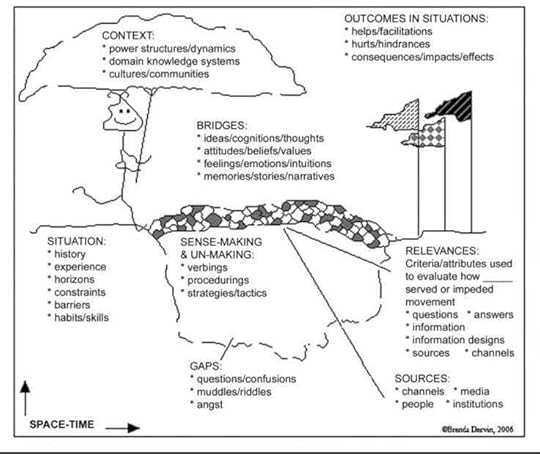 Books
BooksSense-Making Methodology Reader: Selected Writings of Brenda Dervin

Ubiquitous Developments in Knowledge Management: Integrations and Trends edited by Murray Jennex — Chapter 13: Applying Sense-Making Methodology to Design Knowledge Management Practices (with Bonnie Cheuk)
User-Driven Healthcare and Narrative Medicine: Utilizing Collaborative Social Networks and Technologies edited by Rakesh Biswas and Carmel Mary Martin — Chapter 20: Online Learning in Discussion Groups: A Sense-Making Approach (with David J. Schaefer)
Information Seeking Behavior and Technology Adoption: Theories and Trends edited by Mohammed Nasser Al-Suqri and Ali Saif Al-Aufi — Chapter 4: Dervin’s Sense-Making Theory
Encyclopedia of Library and Information Sciences edited by John D. McDonald and Michael Levine-Clark — Chapter: Communication and Communication Studies (with CarrieLynn D. Reinhard); Chapter: Sense-Making (with Charles M. Naumer)
Other Content CV Sense-Making — Oxford Bibliographies Sense-Making Methodology Institute — Dervin’s Sense-Making Methodology Sense-Making Studies (archive) Articles Google Scholar ResearchGate Semantic Scholar AcademicTree Academia.edu Articles by Others In Memoriam: Brenda Dervin — Association for Information Science and Technology (ASIS&T) In Memoriam: Brenda Dervin — The Ohio State University A tribute to Brenda Dervin by Dave Snowden The world loses a treasure: My interactions with Brenda Dervin — Information Matters by Naresh Agarwal Making sense of sense-making: tracing the history and development of Dervin’s Sense-Making Methodology by Naresh Agarwal An interview with Professor Emeritus Brenda Dervin by Matthew Kelly Dervin’s Sense-Making Methodology (SMM) by Jinxuan Ma10 Myths about Information and Information Seeking by Saritza LegaultOnly ‘objective’ information is valuable. “For most tasks and decisions in life, people tend to settle for the first satisfactory solution to a problem, rather than the best solution.”More information is always better. “Typically, there is not a problem getting enough information but rather with interpreting and understanding what information there is.”Objective information can be transmitted out of context. “But people tend to ignore isolated facts when they cannot form a complete picture of them.”Information can only be acquired through formal sources. “This assumption, often made by those in educational institutions, flies in the face of actual behavior.”There is relevant information for every need. “The truth is that mere information cannot satisfy many human needs.”Every need situation has a solution. “But sometimes the client is looking for something — a reassurance, and understanding — that does not come in the shape of a canned response.”It is always possible to make information available or accessible. “Formal information systems are limited in what they can accomplish, at least where the vague, ambiguous, and constantly changing needs of the public are concerned.”Functional units of information, such as books or TV programs, always fit the needs of the individual. “But the ‘functional units’ of the individual are not often these things; rather, they are responses, solutions, instructions, ideas, friendships, and so forth.”Time and space — individual situations — can be ignored in addressing information seeking and use. “Yet it is often the individual’s definition of the situation that shapes his or her needs as much as the ‘real’ situation itself.”People make easy, conflict-free connections between external information and their internal reality. “We lack understanding about how people inform themselves, how they make connections over time, the sense they make of their world between significant events.”[image error]August 25, 2023
Knowledge Management Thought Leader 38: Elizabeth Lank

Now retired, Elizabeth worked as an independent specialist with organizations to help them improve efficiency and effectiveness through greater cross-boundary collaboration and knowledge sharing.
She had a particular interest in helping leaders harness knowledge and information as business assets. Having studied cultural anthropology in college, she gained an early appreciation of the natural human tendency to be tribal — a trait that can be positive in terms of group identity but that can also lead to a counter-productive “us and them” attitude, for example between different business units of the same company.
Before setting up her own business in 2001, Elizabeth worked for IT services company ICL (now Fujitsu Services) for fourteen years in different organizational and leadership development roles, including leading ICL’s Mobilizing Knowledge program for five years. In addition to her advisory role on collaborative working, she was a speaker, facilitator, and program director at business school and in-company leadership development programs.
Elizabeth published multiple articles and books on collaborative working. She was born in Canada, grew up in Switzerland, went to Mount Holyoke College in Massachusetts for her undergraduate years, earned her business degree at INSEAD in France, and has lived in the UK for nearly 40 years. She spent the early part of her career working for the European headquarters of an American computer company in Geneva, Switzerland. She was a member of the international editorial boards of the Journal of Change Management, the Journal of Knowledge Management, and Knowledge Management Review.
EducationINSEAD — Master of Business Administration, 1986Mount Holyoke College — Bachelor of Arts, Cultural Anthropology, 1980ExperienceCollaborative working facilitator and consultant, 2001–2019ICL (now Fujitsu Services), Organizational and leadership development roles, 1986–2000Profiles LinkedIn Twitter Facebook About (archive) Gurteen Knowledge
“Knowledge management is common sense, but not common practice.”
BooksCollaborative Advantage: How Organizations Win by Working Together
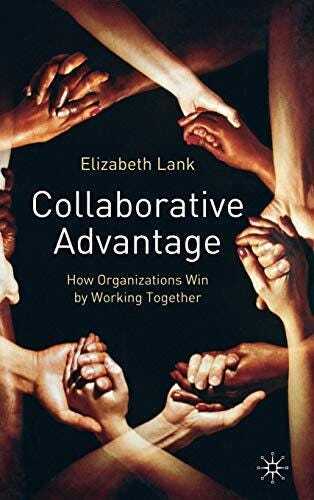
Table of Contents and Chapter Previews
IntroductionDeveloping a Common LanguagePreparing to CollaborateStructuringIntegrating the Team and Agreeing Joint OutcomesNurturing the Collaborative ProcessResourcing the Collaborative EffortCommunicating and Sharing InformationLearningCollaborative Skills, Leadership, and Specialist RolesInternal CollaborationDeveloping Collaborative CapacityBack MatterCommunities of Influence: Improving Healthcare through Conversations and Connections with Alison Donaldson and Jane Maher

The Power of Learning: A Guide to Gaining Competitive Advantage with Andrew Mayo
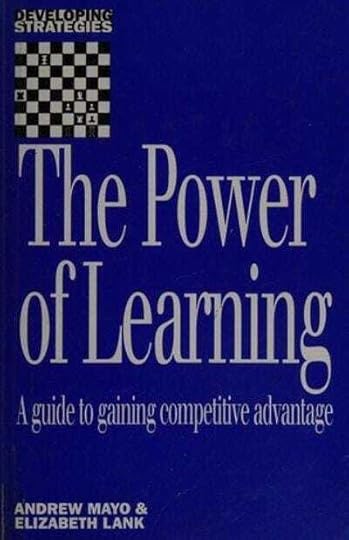
Good Practices in Knowledge Creation & Exchange with Amin Rajan and Kirsty Chapple
Chapter in Knowledge Management: A Real Business Guide, edited by Stuart Rock
Co-author of a chapter in Human Resource Management in International Firms: Change, Globalization, Innovation, edited by Paul Evans, Yves Doz, and André Laurent
Other Content Site (archive) Publications Videos Audio recording: Stimulating organizational learning through networks and communities Articles Semantic Scholar ResearchGate Google Scholar A knowledge-conscious curriculum “Using CoP’s to innovate KM at Macmillan” in Knowledge Management Review, Volume 7, Issue 5, December 2004 — co-authored with Alison Donaldson and Jane Maher“Gaining the knowledge perspective: Reflecting on ICL’s lessons learned” in Knowledge Management Review, Volume 1, Issue 1, March 1998 Building Structural Capital: A New Key to Generating Business Value Book ForewordKnowledge Management: A Blueprint for Delivery by Tom Knight and Trevor Howes
I still remember the day in early 1996 that I stepped into a new role at IT services company ICL [since April 2002, merged with Fujitsu to become Fujitsu Services], as head of a new CEO-sponsored initiative known as the Mobilizing Knowledge program. How I wish I could have referred to a book like this one! The challenge that I had been set was as follows: how could a company of twenty thousand people, spread across more than thirty countries, harness the knowledge it held so that its customers could benefit from its global breadth of experience, not just the knowledge base of the local office? The newly appointed CEO was determined to create a way of working that ensured that the company ‘knew what it knew’ and that its customers could benefit as a result.
I had been interested for some time in the practical challenges of creating so-called ‘learning organizations’, so I took on the role with great enthusiasm. What interested me was not academic theory but the nitty-gritty practicalities of what you do on Monday morning, to really make a difference. As I said, I didn’t have the benefit of a book like this. I started with a largely blank sheet of paper and embarked on a journey that led in many fascinating directions.
The benefit of working in a new field is that you seek out fellow pioneers who share your interest and enthusiasm for the subject. In my time at ICL I discovered a number of fellow enthusiasts who believed in the huge potential of effective knowledge sharing and wanted to share ideas and experience with each other. We formed a cross-company community — nicknamed *MobKnow’ — which developed a pattern of meeting roughly every two months. We learned from each other, challenged each other, and supported each other in times when it sometimes felt that we were speaking a different language to some of our colleagues. The authors of this book were two of the mainstays of that community and have kept its momentum going to this day, long after I (as community founder) had made the leap out of corporate life to mobilize my own knowledge in new settings.
Communities of people who want to share what they know — this of course is the foundation for the effective mobilization of knowledge. The ‘MobKnow’ network in ICL had its electronic space on the company’s intranet but its vitality and usefulness came from the face-to-face discussions that took place. Community members came from many parts of the business, linked by their common interest in knowledge management. Every organization has these communities, but they rarely appear on the organization charts. They cross business, functional and geographic boundaries and they are among the primary channels for knowledge flows. Technology acts as a supporting infrastructure but it is the connections between people that turn an individual’s knowledge and experience into a real organizational asset.
Leaders in 21st century organizations are beginning to appreciate that the competitive advantage of their organizations depends on their ability to foster as many connections between people as possible, building the channels of trust and communication that ensure they will have not just intelligent people but intelligent companies. With luck they will have people like Tom and Trevor in their organizations, catalysts for change who will advise them on how best to tackle this challenge. And whatever happens, they now have this book to turn to for inspiration and practical advice.
[image error]August 18, 2023
Jay Liebowitz: Profiles in Knowledge
 Jay Liebowitz: Profiles in Knowledge
Jay Liebowitz: Profiles in KnowledgeThis is the 94th article in the Profiles in Knowledge series featuring thought leaders in knowledge management. Jay Liebowitz is a professor, consultant, author, and editor living in Washington, DC. His research interests include knowledge management, data analytics, intelligent systems, intuition-based decision making, IT management, expert systems, and artificial intelligence. He has lectured and consulted worldwide.
Background
As of 2021, he is the Visiting Distinguished Professor at the International School for Social and Business Studies in Slovenia. Jay was the Fulbright Visiting Research Chair in Business at Queen’s University for the Summer 2017 and a Fulbright Specialist at Dalarna University in Sweden in May 2019.
Jay has recently served as the inaugural Executive-in-Residence for Public Service at Columbia University’s Data Science Institute. He was previously a Visiting Professor in the Stillman School of Business and the MS-Business Analytics Capstone & Co-Program Director (External Relations) at Seton Hall University. Jay previously served as the Distinguished Chair of Applied Business and Finance at Harrisburg University of Science and Technology. Before that, he was the Orkand Endowed Chair of Management and Technology in the Graduate School at the University of Maryland University College (UMUC). Jay served as a Full Professor in the Carey Business School at Johns Hopkins University.
At Johns Hopkins University, Jay was the founding Program Director for the Graduate Certificate in Competitive Intelligence and the Capstone Director of the MS-Information and Telecommunications Systems for Business Program, where he engaged over 30 organizations in industry, government, and not-for-profits in capstone projects.
Prior to joining Hopkins, Jay was the first Knowledge Management Officer at NASA Goddard Space Flight Center. Before NASA, he was the Robert W. Deutsch Distinguished Professor of Information Systems at the University of Maryland-Baltimore County, Professor of Management Science at George Washington University, and Chair of Artificial Intelligence at the U.S. Army War College.
Jay is the Founding Editor-in-Chief of Expert Systems With Applications: An International Journal. He was the Associate Editor of the international journal, Telematics and Informatics. He has published over 45 books and a myriad of journal articles on knowledge management, analytics, financial literacy, intelligent systems, and IT management. Jay served as the Editor-in-Chief of Procedia-CS (Elsevier). He is also the Series Book Editor of the Data Analytics Applications book series (Taylor & Francis), as well as the Series Book Editor of the new Digital Transformation: Accelerating Organizational Intelligence book series (World Scientific Publishing).
He was ranked one of the top 10 knowledge management researchers/practitioners out of 11,000 worldwide and was ranked #2 in KM Strategy worldwide according to the January 2010 Journal of Knowledge Management. He is a Fulbright Scholar, IEEE-USA Federal Communications Commission Executive Fellow, and Computer Educator of the Year (International Association for Computer Information Systems). In October 2011, the International Association for Computer Information Systems named the “Jay Liebowitz Outstanding Student Research Award” for the best student research paper at the IACIS Annual Conference. He is in the Top 2% of the top scientists in the world, according to a 2019 Stanford Study.
His recent books are Data Analytics and AI (Taylor & Francis, 2021), The Business of Pandemics: The COVID-19 Story (Taylor & Francis, 2021), A Research Agenda for Knowledge Management and Analytics (Elgar Publishers, 2021), Online Learning Analytics (Taylor & Francis, 2022), Digital Transformation for the University of the Future (World Scientific, 2022), Cryptocurrency Concepts, Technology, and Applications (Taylor & Francis, April 2023), and Pivoting Government through Digital Transformation (Auerbach Publications, August 2023). His next book will be Developing the Intuitive Executive: Using Analytics and Intuition for Success (Auerbach Publications, October 2023).
EducationGeorge Washington University
Doctor of Science in system analysis and management/operations research, 1985MBA in finance and investments, 1980BBA in accounting, 1979ProfilesColumbia UniversityNJBDA — New Jersey Big Data AllianceISM University of Management and Economics — LithuaniaResearch.comIGI GlobalContentGoogle ScholarResearchGateSemantic ScholardblpinformsArticlesThe New Star in Organizations: The Chief Knowledge Officer and the Knowledge Audit FunctionIf There is Artificial Intelligence, Is There Such a Thing as Artificial Stupidity?Bridging the Knowledge and Skills Gap: Tapping Federal RetireesCross-Generational Knowledge Flows in Edge Organizations: Research in Progress with Nirmala Ayyavoo and Hang NguyenIntelligent Search for Transforming the Way Organizations WorkKey ingredients to the success of an organization’s knowledge management strategyThe Next Generation of Knowledge Management: Implications for LIS Educators and ProfessionalsCultural Resistance to KM PersistsA Look at Improving Knowledge ManagementKnowledge Retention: What Practitioners Need to KnowHow to Make Knowledge Management More RigorousSMART (Strategize-Model-Act-Revise-Transfer) methodology for KM
Strategize:
Perform strategic planningDetermine key knowledge requirements (i.e., core competenciesSet knowledge management prioritiesPerform business needs analysisIdentify business problem(s)Establish metrics for successConduct cultural assessment and establish a motivate-and-reward structure to encourage knowledge sharingOutputs from the strategize phase:
Business needs analysis documentCultural assessment and incentives documentModel:
Perform conceptual modelingConduct a knowledge auditIdentify types and sources of knowledge (i.e., knowledge assets)Determine competencies and weaknessesPerform knowledge mapping to identify the organization and flow of knowledgePerform gap analysisProvide recommendationsDo knowledge planningPlan knowledge management strategyBuild a supportive, knowledge sharing cultureCreate and define knowledge management initiativesDevelop a cost-benefit analysisPerform physical modelingDevelop the physical architectureDevelop the framework for access, input/update, storage and eventual distribution & useDevelop a high level meta-data designConstruct a visual prototypeOutputs from the model phase:
Knowledge audit documentVisual prototype (i.e., the knowledge map showing the taxonomy and flow of knowledge)Knowledge management program planRequirements specifications documentAct:
Capture and secure knowledgeCollect and verify knowledgeValuate the knowledgeRepresent knowledgeFormalize how the knowledge is representedClassify the knowledge
Encode the knowledgeOrganize and store knowledge in the knowledge management systemCombine knowledgeRetrieve and integrate knowledge from the entire organizationCreate knowledgeHave open discussion with customers and interested parties both internal and external to the organizationPerform exploration and discoveryConduct experimentation (i.e., trial and errorShare knowledgeDistribute knowledgeMake knowledge easily accessibleLearn knowledge and loop back to Step 6Outputs from the act phase:
Knowledge acquisition documentDesign documentVisual and technical knowledge management system prototypesRevise:
Pilot operational use of the knowledge management system;Conduct knowledge reviewPerform quality controlReview knowledge for validity and accuracyUpdate knowledgePerform relevance reviewPrune knowledge and retain what is relevant, timely, and accurate and proven usefulPerform knowledge management system reviewTest and evaluate achieved resultsRevalidate/test against metricsOutputs from the revise phase:
Evaluation methodology and results documentKnowledge management system pilotUser’s guide for the knowledge management systemTransfer:
Publish knowledgeCoordinate knowledge management activities and functionsCreate integrated knowledge transfer programsNotify where knowledge is located and what lessons were learnedPerform serious anecdote management (i.e., publicize testimonials of the benefits of the KMS)Use knowledge to create value for the enterpriseSell (e.g., package knowledgebases for sale)Apply (e.g., knowledge management consulting services, apply methodology)Use (e.g., improve customer satisfaction, employee support and training)Monitor knowledge management activities via metricsConduct post-auditExpand knowledge management initiativesContinue to learn and loop back through the phasesOutputs from the transfer phase:
Maintenance document for the knowledge management systemFull production knowledge management systemPost-audit documentLessons learned documentArticles by OthersDSI’s Inaugural Executive-in-Residence for Public Service is Helping the Federal Government Benefit from Data Science by The Data Science Institute at Columbia UniversityForget Gen Y! Focus on the Disappearing Boomers by Mary AbrahamReview: What they didn’t tell you about KM by Andrea JapzonSIKM Leaders CommunityPosts by and aboutSeptember 17, 2024 PresentationKMWorld ConferenceC303: Developing a KM Strategy & Framework: Lessons Learned & Shared — Slides (with Jack L Price and Ben Apple)Keynote: Building Organizational Intelligence: Knowledge Sharing in the Age of New TechnologiesArticle10 Rules of the Road for KM SuccessKM-Analytics Synergies and the Future of KMModern KM Needs Both Man and Machine, KMWorld Connect Speakers Maintain
10 Rules of the road for Knowledge Management
You need to have a champion among senior leadership and alignment with corporate goals.You need a well-designed KM implementation plan.You need a formal knowledge retention strategy.You need to incorporate KM as part of other strategies.You need to be thoughtful in your application of KM.You need to align KM to corporate culture.You need to celebrate your successes.You need to have the right metrics in place.Don’t force-fit the technology.Know that KM is just one part of strategic intelligence.KMWorld 2016 Keynote Panel: Hacking KMKMWorld 2013 B304: Content Challenges & Opportunities — SlidesKMWorld 2012 A106: Critical Success Factors in KM Initiatives — Slides10 Keys to Success for Knowledge Management Initiatives
Top Ten Keys to Knowledge Management Success
Have A Senior Champion & Align Your KM Strategy With Your Organizational Strategies, Goals, and ObjectivesDevelop A Well-Designed KM Implementation (People, Process, and Technology)Develop a Formal Knowledge Retention Strategy — Start from Day One of the Employee’s Life with the OrganizationIncorporate KM as Part of Human Capital Strategy, Succession Planning, Workforce Development, and/or Quality ManagementBe Thoughtful in Your Approach (Knowledge Audit, Social Network Analysis, etc.)Align Your KM Approaches to Fit Your Organizational CultureCelebrate the Successes, Then Bring in the Bittersweet StoriesDevelop KM Metrics, Especially Outcome MeasuresDon’t Force-Fit Technology (People/Culture/Process Are Where the Rubber Hits the RoadKM is Just One Part of Your “Strategic Intelligence”Knowledge Sharing Tenets for Success
Enhance reward and recognition system to include learning and knowledge sharing competenciesAcquaint people with knowledge sharing and its benefitsShare the message that with creativity comes failure and we all benefit from talking about our successes and our failuresIntegrate knowledge sharing into everyone’s jobEducate people about what types of knowledge are valuable and how they can be usedMake sure the technology works for people, not vice versaPodcastKnowledge Management and Analytics with Chelsea BarrettTranscriptVideosHow Artificial Intelligence, Analytics, & Internet Affect Our Liveshttps://medium.com/media/db62aac5785378aef6c91ab7822f2080/hrefInaugural HHS Executive Knowledge Management Summit — 2019https://medium.com/media/92471356a60a7814a82bf141b75dbbf4/hrefWhy KM Efforts Failhttps://medium.com/media/23d8c904038cf6e5bc1767a75295483b/hrefKM-Analytics Synergies and the Future of KMhttps://medium.com/media/0f9ed09bddab2034892d0f433da23287/href10 Rules of the Road for KM Successhttps://medium.com/media/3e75ce2fe11a67dd3f9e25df1d67b051/hrefKnowledge Management in the Technical information Centerhttps://medium.com/media/6b436d1393adfd219468d94c12f90c50/hrefBeyond the Great Recession: Possibilities and Predictionshttps://medium.com/media/736d75621e53325137e59dddadb35a9e/hrefIntuition Based Decision Makinghttps://medium.com/media/93b6b48e72e5a6873d14546c7fa89ab9/hrefKnowledge Management and e-Learning: Putting Theory into Practicehttps://medium.com/media/d40de6f6574c894fabf9b09596884f2c/hrefBooksAmazonKnowledge ManagementKnowledge Management Handbook: Collaboration and Social Networking, Second Edition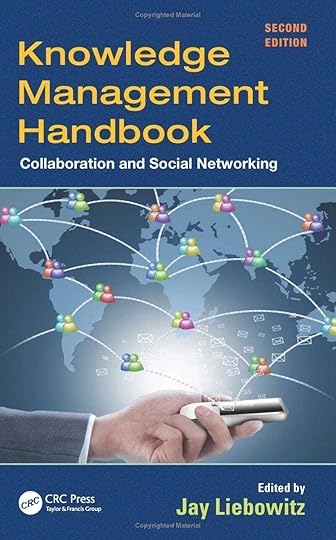 Knowledge Management Handbook, First EditionBeyond Knowledge Management: What Every Leader Should Know
Knowledge Management Handbook, First EditionBeyond Knowledge Management: What Every Leader Should Know Successes and Failures of Knowledge Management
Successes and Failures of Knowledge Management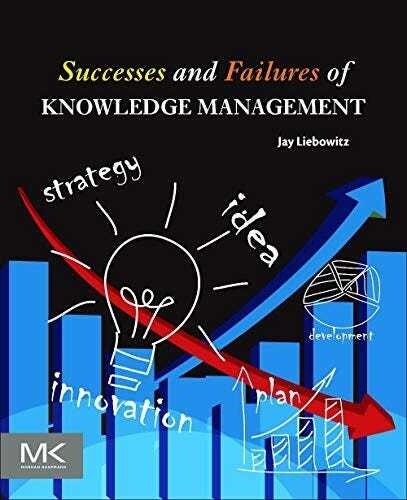 Knowledge Management: Learning from Knowledge EngineeringMaking Cents Out of Knowledge ManagementWhat They Didn’t Tell You About Knowledge ManagementKnowledge Management and E-Learning with Michael FrankKnowledge Retention: Strategies and SolutionsStrategic Intelligence: Business Intelligence, Competitive Intelligence, and Knowledge ManagementKnowledge Management in Public Health edited with Richard A Schieber and Joanne AndreadisBuilding Organizational Intelligence: A Knowledge Management PrimerAddressing the Human Capital Crisis in the Federal Government: A Knowledge Management PerspectiveKnowledge Organizations: What Every Manager Should Know with Tom BeckmanKnowledge Management and its Integrative Elements edited with Lyle C. WilcoxSocial Networking: The Essence of InnovationHandbook of Knowledge Management Vol. 1 edited by Clyde Holsapple — Chapter 21: Knowledge Sharing Proficiencies — with Yan ChenDigital TransformationPivoting Government through Digital Transformation
Knowledge Management: Learning from Knowledge EngineeringMaking Cents Out of Knowledge ManagementWhat They Didn’t Tell You About Knowledge ManagementKnowledge Management and E-Learning with Michael FrankKnowledge Retention: Strategies and SolutionsStrategic Intelligence: Business Intelligence, Competitive Intelligence, and Knowledge ManagementKnowledge Management in Public Health edited with Richard A Schieber and Joanne AndreadisBuilding Organizational Intelligence: A Knowledge Management PrimerAddressing the Human Capital Crisis in the Federal Government: A Knowledge Management PerspectiveKnowledge Organizations: What Every Manager Should Know with Tom BeckmanKnowledge Management and its Integrative Elements edited with Lyle C. WilcoxSocial Networking: The Essence of InnovationHandbook of Knowledge Management Vol. 1 edited by Clyde Holsapple — Chapter 21: Knowledge Sharing Proficiencies — with Yan ChenDigital TransformationPivoting Government through Digital Transformation Digital Transformation for the University of the FutureIntuitionDeveloping the Intuitive Executive: Using Analytics and Intuition for Success
Digital Transformation for the University of the FutureIntuitionDeveloping the Intuitive Executive: Using Analytics and Intuition for Success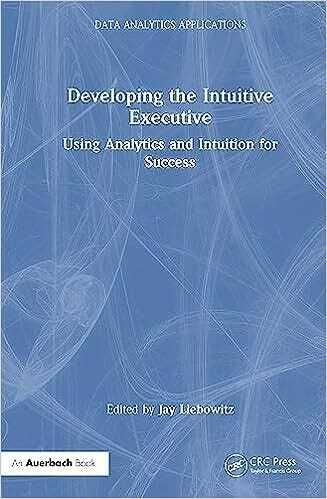 Bursting the Big Data Bubble: The Case for Intuition-Based Decision MakingIntuition, Trust, and Analytics With Joanna Paliszkiewicz and Jerzy GołuchowskiDeveloping Informed Intuition for Decision-MakingHow Well Do Executives Trust Their Intuition edited with Yolande Chan, Tracy Jenkin, Dylan Spicker, Joanna Paliszkiewicz, and Fabio BabiloniAnalytics and AIA Research Agenda for Knowledge Management and Analytics
Bursting the Big Data Bubble: The Case for Intuition-Based Decision MakingIntuition, Trust, and Analytics With Joanna Paliszkiewicz and Jerzy GołuchowskiDeveloping Informed Intuition for Decision-MakingHow Well Do Executives Trust Their Intuition edited with Yolande Chan, Tracy Jenkin, Dylan Spicker, Joanna Paliszkiewicz, and Fabio BabiloniAnalytics and AIA Research Agenda for Knowledge Management and Analytics Data Analytics and AIBig Data and Business AnalyticsBusiness Analytics: An IntroductionOnline Learning AnalyticsThe Handbook of Applied Expert SystemsManaging Expert Systems edited with Efraim TurbanIT ManagementInformation Technology Management: A Knowledge RepositoryCases on Information Technology Management in Modern Organizations edited with Mehdi KhosrowpourCommunicating As IT Professionals with William Agresti and G. Reza Djavanshir[image error]
Data Analytics and AIBig Data and Business AnalyticsBusiness Analytics: An IntroductionOnline Learning AnalyticsThe Handbook of Applied Expert SystemsManaging Expert Systems edited with Efraim TurbanIT ManagementInformation Technology Management: A Knowledge RepositoryCases on Information Technology Management in Modern Organizations edited with Mehdi KhosrowpourCommunicating As IT Professionals with William Agresti and G. Reza Djavanshir[image error]
August 17, 2023
9th Annual Midwest KM Symposium: Part 8: Linda Lavelle

This is the eighth and final post in the series about the Midwest Knowledge Management Symposium held June 16, 2023 at Kent State University. This post is about the seventh presentation in Track 1 (People and Processes) delivered by Linda Lavelle.

Linda Lavelle is a knowledge management leader who believes that the best knowledge in an organization can be identified, personalized, and shared to drive successful business outcomes.
Linda had a 32-year career at Johnson & Johnson where she combined a people and process focus with her project management and innovation experience to create tailored knowledge management solutions. Since leaving Johnson & Johnson in 2022, Linda has followed her passion for knowledge management and started her own consulting firm, Knowledge Dynamics, to help organizations harness their greatest asset — their knowledge.
During her tenure as Director of Knowledge Management and Innovation at Johnson & Johnson, Linda developed the Supply Chain Knowledge Network accessed by over 20,000 employees annually, creating curated, trusted source of Supply Chain knowledge. She enabled over $50 million in savings by developing and providing oversight of 26 Knowledge Centers focused on key strategic topics. Linda was also instrumental in driving a culture of innovation by leading an innovation collaboration platform that hosted 200 challenges in 81 countries, generated 20,000 ideas, and realized $30 million in predicted savings.
Knowledge Management and Innovation: Partnering to Create Impact by Linda Lavelle
Linda began by presenting six knowledge activities she grouped under the category of Fit:
CreateUseTransferAcquireRetainShe then showed knowledge sharing actions using examples from the Fast Track Ideas Innovation Collaboration Platform used by the Johnson & Johnson Supply Chain:
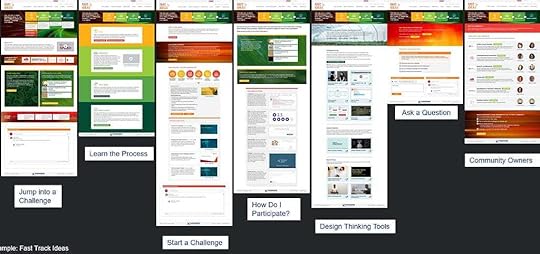 Jump into a challengeLearn the processStart a challengeFind out how to participateUse design thinking toolsAsk a questionContact community owners
Jump into a challengeLearn the processStart a challengeFind out how to participateUse design thinking toolsAsk a questionContact community ownersLinda next discussed communities:
They are extremely important for the innovation collaboration platform.A central repository of ideas across innovation challenges was maintained.A core working group provided governance.She differentiated between two types of collaboration:
Microsoft Yammer worked well broadly.Microsoft Teams worked for the core team.There are 26 Knowledge Centers in the Johnson & Johnson knowledge network. They provide a single source of truth through widespread access.
Other PresentationsThere were three parallel tracks at the symposium, so I was unable to attend all the sessions. Here are links to the other ten presentations and the associated speakers:
Track 1: People and Processes You’ve Implemented Knowledge: Now What? by Jessica DeMay and Heather Irvin Hauser Embracing Personal KM after a 23-Year Career in the U.S. Navy by Cindy Young Track 2: Technology and Digital Transformation AI Ethics and its Impact on Knowledge Management by Tony Rhem Know the unknown faster with Rapid Learning Cycles by Jim Clarke A knowledge Sharing Portal for a Sustainable Smart City Future by Christina Turner , Kendra Albright , and Bill Edgar Enterprise Taxonomy: Can Chartis Go from Good to Great? by Darrin Brogan Track 3: Organization Development and KM as a Profession Rightsizing Your KM Function: Defining an Achievable Vision that Fits Your Organizational Purpose, Needs and Structure by Ari Kramer Knowledge Management Made Simpler, But Not Necessarily Easier! Lessons from KM in Practice by Bill Kaplan Organizational Culture and AI by John Antill — ( handout ) To ISO or not to ISO by Patricia EngThe 9th Midwest KM Symposium was a huge success, and plans are underway to hold the 10th symposium next year. I had the good fortune to be able to help plan the event, give a presentation, distribute and sign copies of my book for all attendees, and attend eight other sessions.
Thanks to everyone who helped by planning, executing, presenting, and attending, especially co-chairs Linda Hummel and Kendra Albright; the other planning team members, Tammy McKenna, Maggie Starkey, Susan Montgomery, Edwin K. Morris, Bill Kaplan, Ninez Piezas-Jerbi, and Guillermo Galdamez; sponsors Lucidea, Enterprise Knowledge, and Bloomfire; keynote speakers Thomas A. Stewart and Zach Wahl; and the host Kent State School of Information.
This concludes this 8-part series. Part 7 featured Maggie Starkey.
[image error]August 11, 2023
9th Annual Midwest KM Symposium, Part 7: Maggie Starkey

This is the seventh in a series of posts about the Midwest Knowledge Management Symposium held June 16, 2023 at Kent State University. This post is about the sixth presentation in Track 1 (People and Processes) delivered by Maggie Starkey.
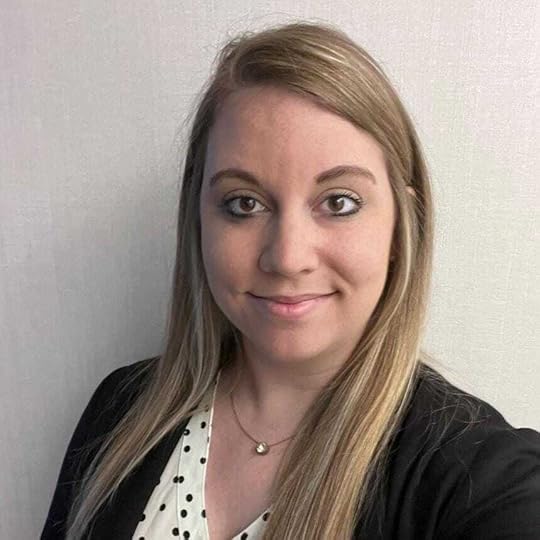
Maggie Starkey is an accomplished knowledge management specialist with over ten years of experience in multiple roles in the manufacturing industry. She is an innovator who seeks out opportunities for improvements and implements new ideas to make a positive difference for her colleagues at Kraton Corporation.
In 2020, she found her passion for knowledge management after seeing the vast amount of knowledge being lost at Kraton and became the key player in the creation and implementation of the knowledge management program. She holds an associate degree in business management and a BS in Public Relations and Marketing. She will also complete her MS in Knowledge Management in December of 2023.
Building on knowledge gained from experience and higher education, she regularly attends conferences and training to continually increase her expertise in knowledge management and other key areas that tie directly to KM. She is a change agent for Kraton, continually developing and implementing new tools and mechanisms to improve work processes and share knowledge across the R&D organization she represents. She is active in the SIKM Leaders Community and plans to start blogging.
How to Make KM Stick: Steps to Achieving a Knowledge Sharing Culture by Maggie Starkey

Maggie stressed the importance of buy-in from leadership and strong governance. She advised doing the following:
Develop a strategy with clear tie to business objectives.Appoint a steering team.Define formal roles, responsibilities, and processes.Engage first level managers because they are key to transforming the culture.Stress to all managers they need to walk the talk and lead by example.She recommended recruiting early adopters and advocates, designating them as Knowledge Champions. This includes seeking out potential advocates behind the scenes.
Maggie shared how Kraton does rewards and recognition. She described their KM Excellence Award and Peer Recognition programs.
She suggested finding pain points in the organization and alleviating them with KM solutions in the flow of work. For Kraton, these included:
Expertise LocationContent Management and SearchElectronic Lab NotebooksMaggie asserted that the most important thing to do is to build trusting relationships with your people. She said, “All I do is change management.” She recommended identifying the best forms of communication for each phase in the Prosci change management model.
The final slide Maggie presented was about making KM stand out and making it fun through:
Specific KM program brandingContests and trivia with prizesCelebrating all the hard work doneMaggie’s presentation was well received. To continue expanding her knowledge, she picked up two books written by symposium speakers:
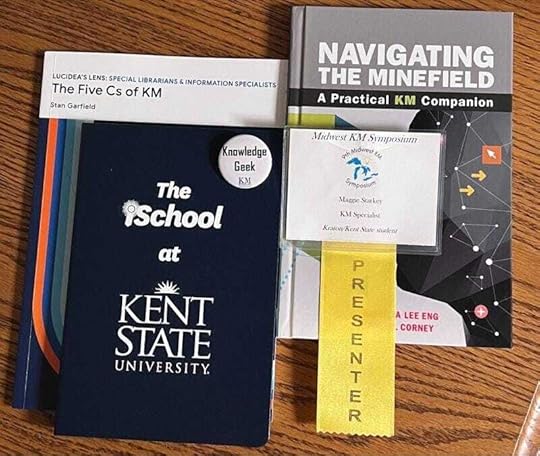
Maggie was a member of the planning committee for the symposium. And she used her artistic creativity to design the logo used for the event:
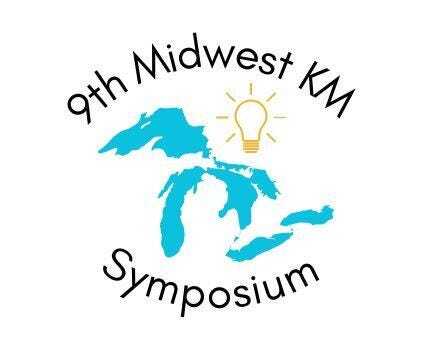
Part 8 of this series will feature Linda Lavelle. Part 6 featured Rachel Teague.
[image error]August 4, 2023
9th Annual Midwest KM Symposium: Part 6: Rachel Teague

This is the sixth in a series of posts about the Midwest Knowledge Management Symposium held June 16, 2023 at Kent State University. This post is about the fifth presentation in Track 1 (People and Processes) delivered by Rachel Teague.

Rachel Teague is a rising KM transfer and retention expert, consultant, speaker, writer, master trainer and facilitator, collaborator, and education professional. Throughout her life she has lived through change, growth, transition, and restructure. She has leveraged these experiences, both positive and negative, to inform her outlook and understanding of how organizations work and thrive. This, combined with her education, training, and certifications, gives her a unique worldview and allows her to effectively understand and communicate with people at every level of an organization, and deliver work products that are user-friendly, readily understood, effective, and easily integrated into complex system.
As a result of Rachel’s case study, How an Effective Knowledge Management Program Supports Critical Tacit Knowledge Retention Within a Higher Education Institution: A Qualitative Intrinsic Case Study, she developed tools educators can add to their experiential tool belts as they navigate new challenges facing education, including retirement, staffing changes, and budget cuts. As the world of education evolves, shifting with these changes is necessary to effectively adapt and provide the best opportunities for the learning ecosystem.
Applying Knowledge Transfer: Real Life Tools in Real Life Examples by Rachel Teague
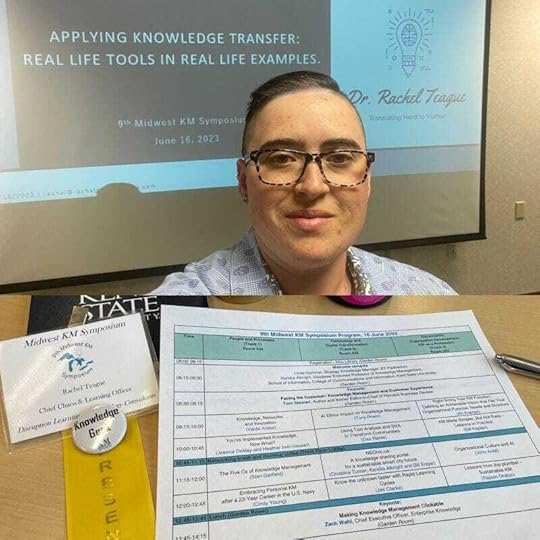
Rachel began by sharing four themes based on her findings from her efforts:
A strong community and culture can facilitate openness in knowledge sharing.Stakeholder buy-in is needed to create a robust learning organization.Transparency assists in breaking down silos.Training and consulting can help prevent critical knowledge loss.She provided details on the Knowledge Retention Program pilot:
Defined a framework to formalize and standardize how to capture this type of knowledge.Curated a multimodal toolkit and repository.Marketed the Knowledge Retention Program as an enterprise-wide service to effectively capture and share critical knowledge.Rachel offered this slide showing the high-level process she used:
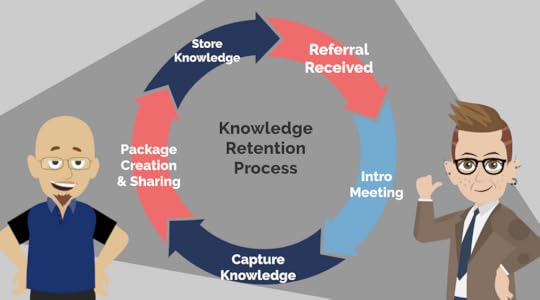
She provided four proven practices for capturing knowledge:
Foster a positive rapport.Practice active listening and open questioning.Take lots of notes.If possible, utilize video.Rachel added that you don’t know what you don’t know, and you might uncover something important in the process.
She concluded her presentation with a depiction of the elements of a learning organization. These make up a sequence of onboarding, on-the job training, experience, knowledge capture, development, knowledge sharing, knowledge retention, and offboarding knowledge incorporation.
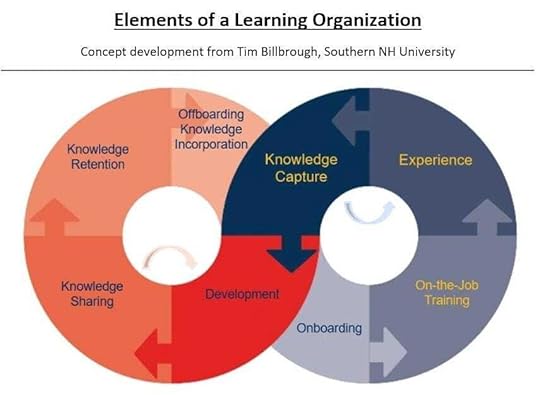
Rachel’s presentation was succinct and conveyed useful advice that can be applied by anyone involved with knowledge capture, transfer, and retention.
Part 7 of this series will feature Maggie Starkey. Part 5 featured Rajesh Dhillon.
[image error]July 28, 2023
9th Annual Midwest KM Symposium: Part 5: Rajesh Dhillon

This is the fifth in a series of posts about the Midwest Knowledge Management Symposium held June 16, 2023 at Kent State University. This post is about the third presentation in Track 3 (Governance, Organization Development, and KM as a Profession) delivered by Rajesh Dhillon, who traveled all the way from Singapore to give his talk.

Rajesh Singh Dhillon started his KM journey with the Singapore Navy, retiring after 23 years as a naval commander. In Singapore he is an Associate Faculty at Nanyang Technological University and Singapore University of Social Science, where he teaches KM Strategy and Information Management at the Master’s and Bachelor’s level, respectively.
Rajesh is also the Knowledge Architect at Acies Innovations in Singapore, where he provides consulting services in the areas of leadership development, knowledge and performance management, employee engagement, and organizational learning.
As the President of Knowledge Management Society, Singapore and one of the founding members of Knowledge Management Global Network, Rajesh is a well-known figure in the professional KM community in Singapore and Asia.
His roles have included ISO 30401 KM consultant, lead evaluator of the Knowledge Ready Organization (KRO) awards, and member of the international judging panel for the Most Innovative Knowledge Enterprise (MIKE) awards.
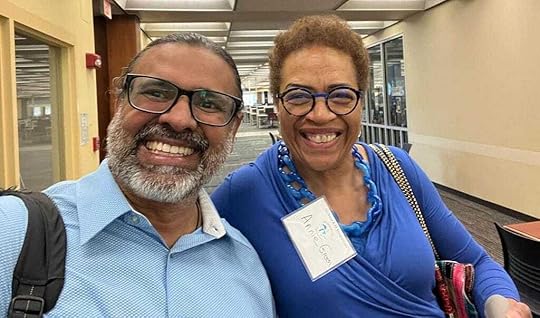 Rajesh Dhillon with
Annie Green
at the Midwest KM Symposium
Rajesh Dhillon with
Annie Green
at the Midwest KM SymposiumSustainable Knowledge: Lessons from My Plumber by Rajesh Dhillon
Rajesh began by listing the similarities in the professions of plumbing and knowledge management. He noted that while there is complexity in both jobs, they both involve fixing leaks.
He shared terms from plumbing that are also used to describe knowledge challenges:
Knowledge SeepageKnowledge LossKnowledge LeakBrain DrainRajesh asserted that an organization’s competitive advantage can be lost if knowledge and/or experience is lost or leaked. He then showed how leaks occurred, both pre- and post-COVID:
Pre-COVID Knowledge Leak
Outsourcing: does not facilitate a complete transfer of knowledge and know-how, especially when workers face redundancyReorganization and mergers: cutting employees without consideration of differing levels of worthSubject Matter Experts: if dependent on the skills of key employees, what happens when they leave?Post-COVID Knowledge Leak
Retirement: Millions of Baby Boomers retire annually, and there was a COVID-19 recessionResignation: workers have their pick of offers, and many cite uncaring employers and a lack of scheduling flexibilityHe defined a Sustainable Development Goal (SDG) with one aim with four focus areas:
Leadership: Strong emphasis on leaders’ capabilities and knowledgeTransformation: Making it work betterWork Practices: Ensure meaningful work by understanding employee trendsCareer Development: Growth and development within the sectorRajesh showed three charts that outlined Knowledge Management SWOT (Strengths, Weaknesses, Opportunities, Threats):
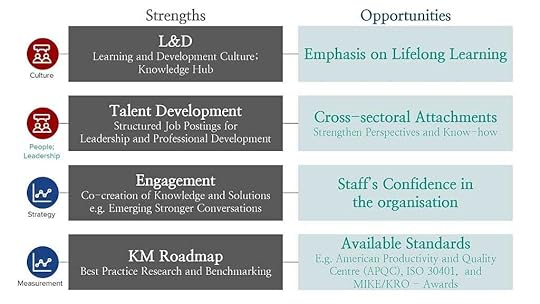
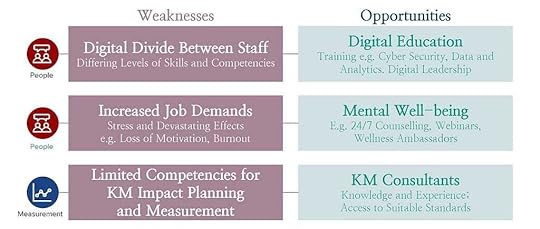
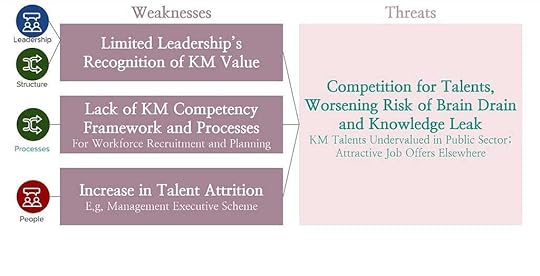
Returning to his comparison of KM and plumbing, Rajesh said that both require a systematic approach and resources to be effective. Both knowledge management systems and plumbing systems require ongoing maintenance and quality control. Knowledge needs to be regularly reviewed and updated to ensure its relevance and accuracy. Plumbing systems require regular inspection, maintenance, and repairs to prevent leaks, ensure safety, and comply with regulations. Without proper maintenance and quality control, both knowledge and plumbing systems can become inefficient and ineffective.
Rajesh provided four recommendations, each three underlying points:
Recommendation #1: Leveraging technologies to harness KM capabilities further, while balancing the need for human intervention and protection against cyber attacks
Technologies can be wrongNeed for human touch when technologies failIncreased number of data breaches could affect client confidenceRecommendation #2: Embedding KM strategies into business strategies and developing a KM roadmap
Need to sell KM benefits to senior management given hefty resourcesKM strategies to be aligned with business strategiesKM roadmap to allow clarity for staff and seek greater buy-inRecommendation #3: Highlighting the importance of continuous learning and embracing future work
Learning and sharing should not be tedious, thus acting as a deterrenceInnovation will open possibilities for new work areasNurture a culture of continuous learning to strengthen staff capabilitiesRecommendation #4: Recognizing KM contributions as a criterion for job promotions, supplemented with people management skills
Motivate staff for KM contributions through job promotions, bonus and special titlesFamiliarize new hires with tech toolsRegular training for existing staffHe offered a list of 16 critical core skills for the future of work:
Cluster #1: Thinking critically
Creative thinkingDecision makingProblem-solvingSensemakingTransdisciplinary thinkingCluster #2: Interacting with others
Building inclusivityCollaborationCommunicationCustomer orientationDeveloping peopleInfluenceCluster #3: Staying relevant
AdaptabilityDigital fluencyGlobal perspectiveLearning agilitySelf-managementRajesh concluded his presentation by supplying a leak toolkit in two parts:
Leak Toolkit, Part 1 — Preventive measures for learning before, during, and after projects:
Connect people to information and knowledge
Case Study — share experience from project progress and outcomesKnowledge bank — repositories so that we have accumulated knowledge at handRapid Evidence review — build a new baseline so new projects spiral up and not start from zeroConnect people to people
Community of Practice — learning from shared experiences and best practicesPeer Assist — first-hand knowledge transferKnowledge Café — informal learning through dialogueKnowledge Marketplace — push required knowledge to people and allow people to pull knowledgeOrganizational Learning
After Action Review — tacit knowledge captureRetrospect — capture lessons learned and publish for all to learnKnowledge Exchange — exit interviews, mentoring, coachingLeak Toolkit, Part 2: — Guide to capturing and storing knowledge:
Establish KM program objectives (strategy)Build a KM implementation roadmapBuild a taxonomyConduct handover and exit interviewsCreate a how-to guideCreate staff profile pages (expert directories)Establish shared networks, blogs, and discussion forumsRajesh’s presentation was both light-hearted and thoughtful. Those who attended it appreciated both his humor and his insights.
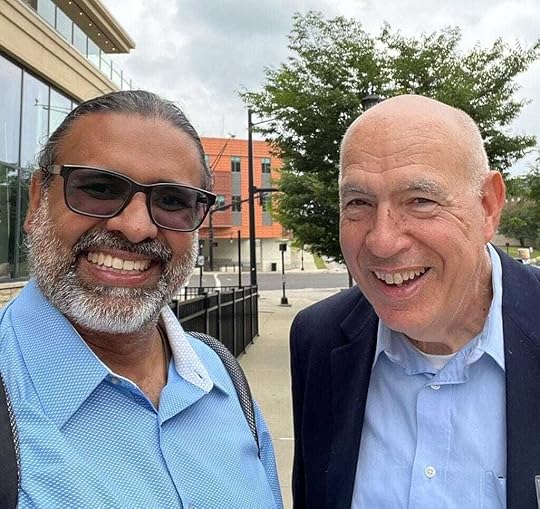 Rajesh with me during our walk following the symposium
Rajesh with me during our walk following the symposiumPart 6 of this series will feature Rachel Teague. Part 4 featured Dan Ranta.
[image error]


